Physical Address
304 North Cardinal St.
Dorchester Center, MA 02124
Infectious pathology can result in a variety of basic patterns of pulmonary pathology including acute lung injury, alveolar filling, cellular infiltrates, nodules, and fibrosis in order of decreasing frequency ( Table 7.1 ). Acute lung injury is the most common basic pattern encountered in infection and may be secondary to all forms of infection (bacterial, viral, fungal, protozoan, parasitic). Alveolar filling, typically with fibrin or polyps of organizing pneumonia is also a frequent presentation for infection. Many infections can present as nodules, and it is not uncommon to diagnose an infectious process on a needle core biopsy of a nodule or mass lesion. Finally, chronic (usually bacterial) pneumonia will produce a distinctive scarring over time that can be mistaken for fibrotic interstitial lung disease if the histology is interpreted in isolation from the clinical history and imaging studies. Regardless of the basic pattern encountered in a particular case, histologic clues that suggest infection as the etiology of a pathologic process include the presence of necrosis, neutrophilic infiltrates, granulomas, and viral cytopathic effect ( Box 7.1 ).
|
|
|
|
|
|
|
|
|
|
|
|
|
|
|
Acute lung injury
Necrosis
Neutrophilic infiltrates
Granulomas
Viral cytopathic effect
This chapter is divided into two sections. The first describes useful tools and strategies for the pathologic approach to the lung biopsy for infection and the second is a compendium of individual infectious agents and their pulmonary manifestations.
Lower respiratory tract infections are a leading cause of morbidity and death worldwide. , A relatively small percentage of these infections come to the attention of the surgical pathologist because most are diagnosed in the microbiology laboratory. Pulmonary infections typically undergo biopsy when a diagnosis has either eluded standard microbiologic techniques (sputum, bronchial lavage, blood culture), has not responded to empirical therapy, or requires morphologic analysis for clarification of a critical aspect of the differential diagnosis. In these situations, the diagnostic pathologist is indispensable, , sometimes even providing an immediate report intraoperatively or the next day with rapid tissue processing systems.
Pathology and microbiology have long been intertwined medical disciplines. Pathologists who combine their diagnostic techniques with those of the microbiology laboratory achieve the best diagnostic yield when infection is a diagnostic consideration. Unfortunately, the diagnostic work-up and reporting of findings in anatomic pathology and microbiology typically run along independent paths, often without one group knowing (or acknowledging) the findings of the other. For example, it is uncommon for the diagnostic pathologist to contact the microbiology laboratory to report that a tissue or cytology stain has identified an organism. An interdisciplinary approach based on mutual understanding and communication is the ideal scenario for clinical management. The pathologic report should reflect the relevant findings from the microbiology laboratory whenever possible, especially if cultures have been submitted from tissue samples or aspirates received during intraoperative consultation or aspiration procedures.
Knowing the patient’s risk factors and immune status is particularly important for infectious diseases because typically these parameters have a profound influence on the spectrum of histopathologic changes observed, the types of etiologic agents to be considered, and number of organisms present in a specimen. The degree of immunosuppression can influence the burden of organisms making the etiologic organisms more difficult to demonstrate in tissue or cytologic specimens. For example, organisms are less often found in lung tissues from patients with normal or near-normal immunity. In this setting, cultures, serologic studies, and epidemiologic data must be relied on to provide the diagnosis. Consider the tedious search required for acid-fast organisms in reactivation tuberculosis granulomas versus the innumerable organisms of Mycobacterium avium infection in patients with the acquired immunodeficiency syndrome (AIDS). In the AIDS patient, M. avium infection typically manifests poorly formed granulomas or simply histiocytic infiltrates, with an overabundance of organisms identified by tissue acid-fast stains. Similarly, Pneumocystis organisms may be easily identified in patients with AIDS, but when immunosuppression is less severe (such as that produced by corticosteroids therapy for arthritis), the organism is rare. The relationship between the level of immunity, burden of organisms, and patterns of disease is illustrated for cryptococcosis in Fig. 7.1 . In the immunocompromised patient, there is always a broad differential diagnosis. In addition to infection, other disorders come into consideration, such as pulmonary involvement by preexisting disease, drug-induced and treatment-related injury, noninfectious interstitial pneumonias, malignancy, and new pulmonary diseases unrelated to the patient’s immunocompromised state, such as aspiration, heart failure, and pulmonary embolism. When immunosuppression is intentional, as in transplant recipients, unique additional challenges come into play, such as transplant rejection, graft-versus-host disease, and Epstein–Barr virus (EBV)–associated lymphoproliferative disorders. Immunosuppressed persons are at risk for multiple simultaneous infections, so when one organism is found, a careful search for others is always warranted ( Fig. 7.2 ). Review of the chest imaging studies and the pace of the disease (acute, subacute, and chronic) can be very helpful in arriving at a clinically relevant diagnosis ( Fig. 7.3 ). Fortunately, the recognized histopathologic patterns of lung infection are limited (acute lung injury, alveolar filling, and nodules), and these typically correlate with a particular group of organisms.
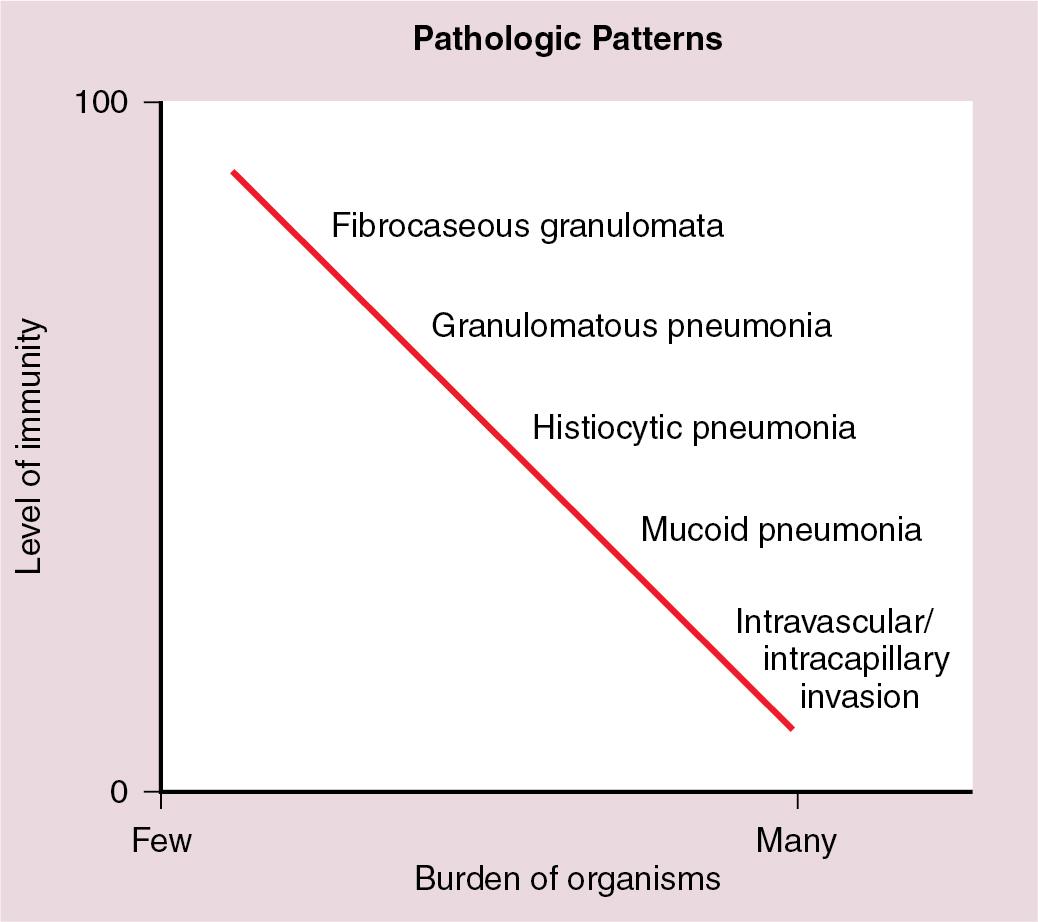
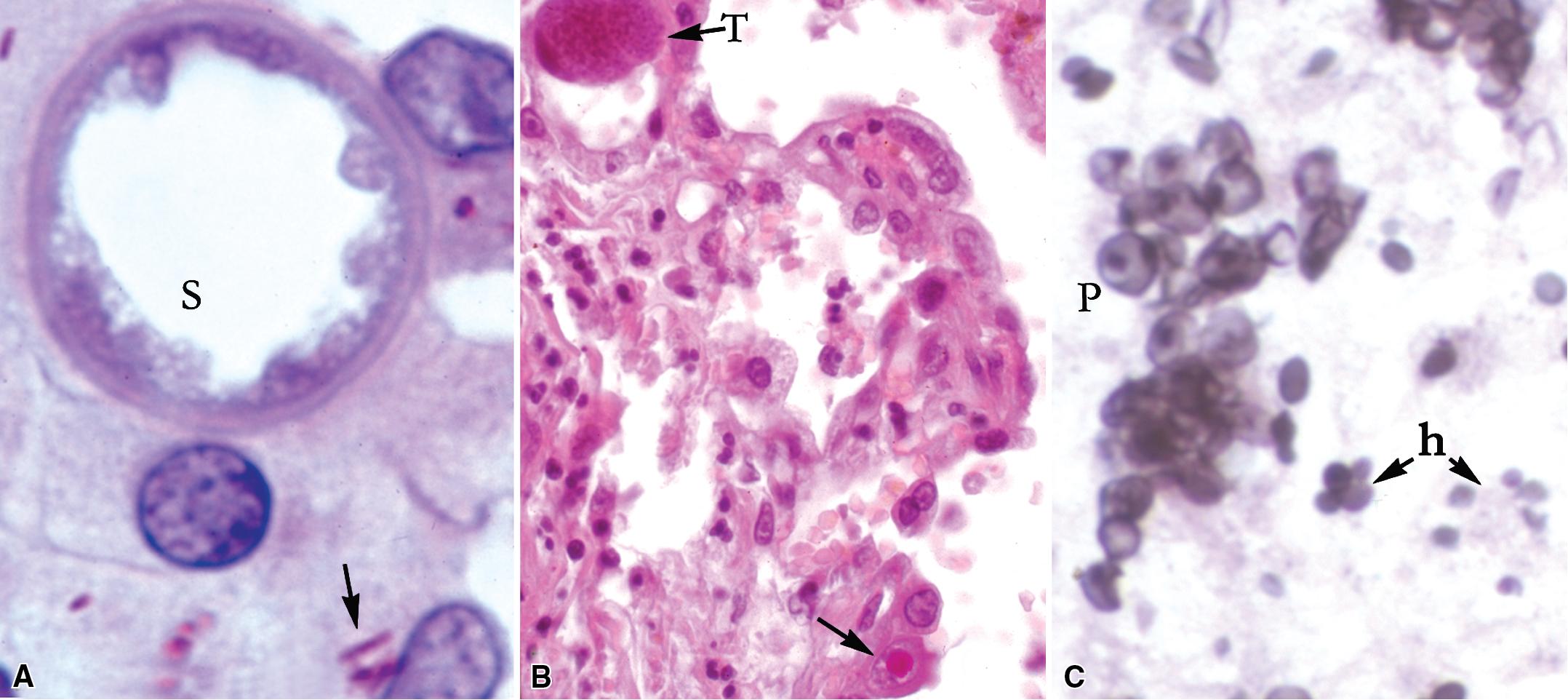
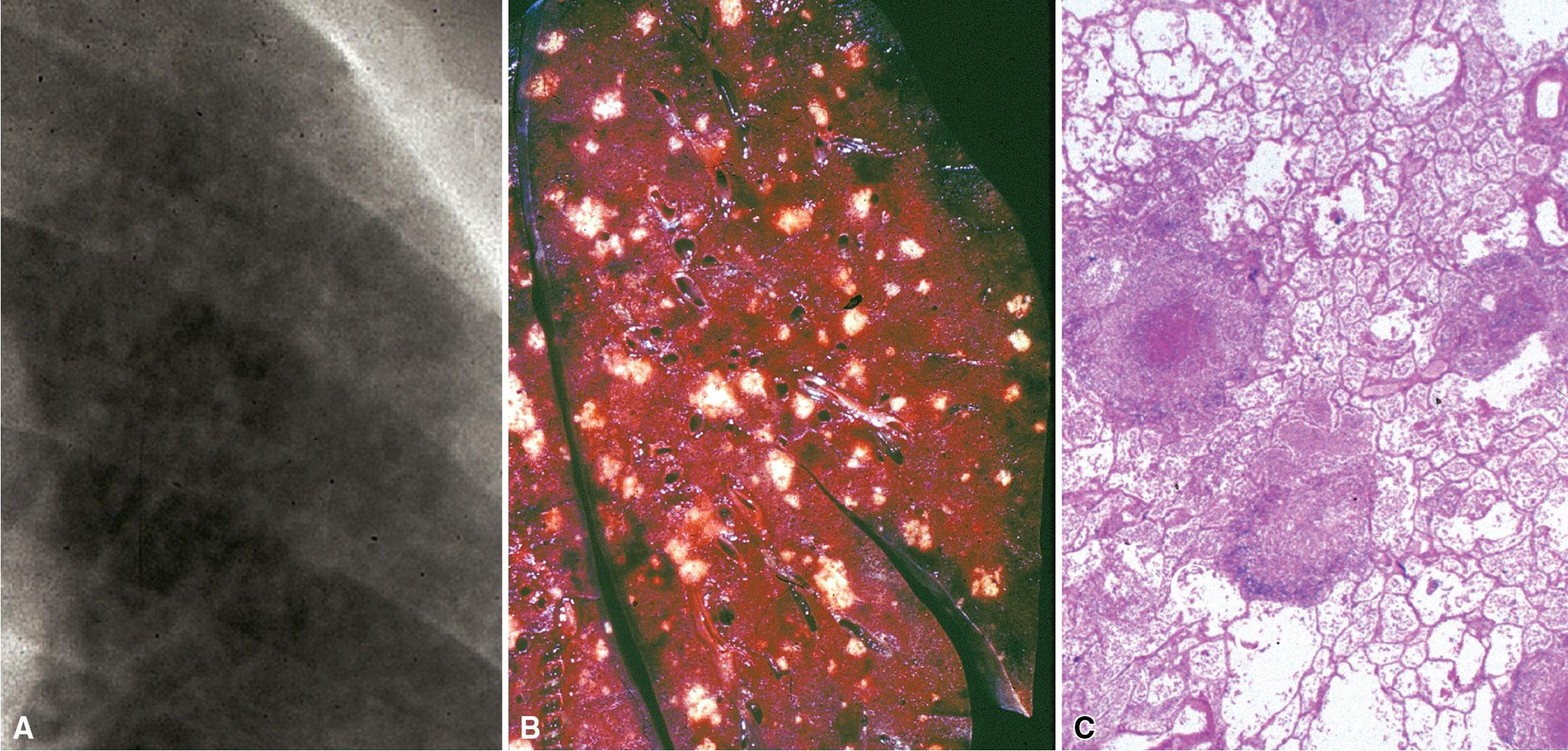
Some pathologists have an aversion to the use of special stains for identifying organisms in tissue sections based on perceived low specificity and sensitivity and the technical difficulty of performing some of these (especially silver impregnation methods, such as the Dieterle, Steiner, and Warthin-Starry stains). Nevertheless, several histochemical staining techniques are quite useful in detecting bacteria, mycobacteria, and fungi in tissue sections. These stains should be applied as part of an algorithmic strategy for acute lung injury, especially in the immunocompromised patient. For example, when bacteria are being sought, some pathologists would prefer to begin with the tissue Gram stain (e.g., Brown and Hopps, Brown and Brenn), but silver impregnation techniques (e.g., Warthin-Starry) are actually more sensitive and a good starting point for approaching a suspected bacterial infection. By coating the bacteria with metallic silver, the bacterial silhouettes are enhanced ( Fig. 7.4 ) and become more visible. Other stains (e.g., Giemsa) will sometimes detect bacteria that do not stain well with more conventional stains ( Fig. 7.5 ). The Grocott methenamine silver (GMS) stain ( Fig. 7.6 ) is the best stain for most fungi in tissue; it also stains Actinomycetes, Nocardia , Pneumocystis (cysts), free-living soil amebae, algal cells, the spores of certain microsporidia, and the cytoplasmic inclusions of cytomegalovirus (CMV).
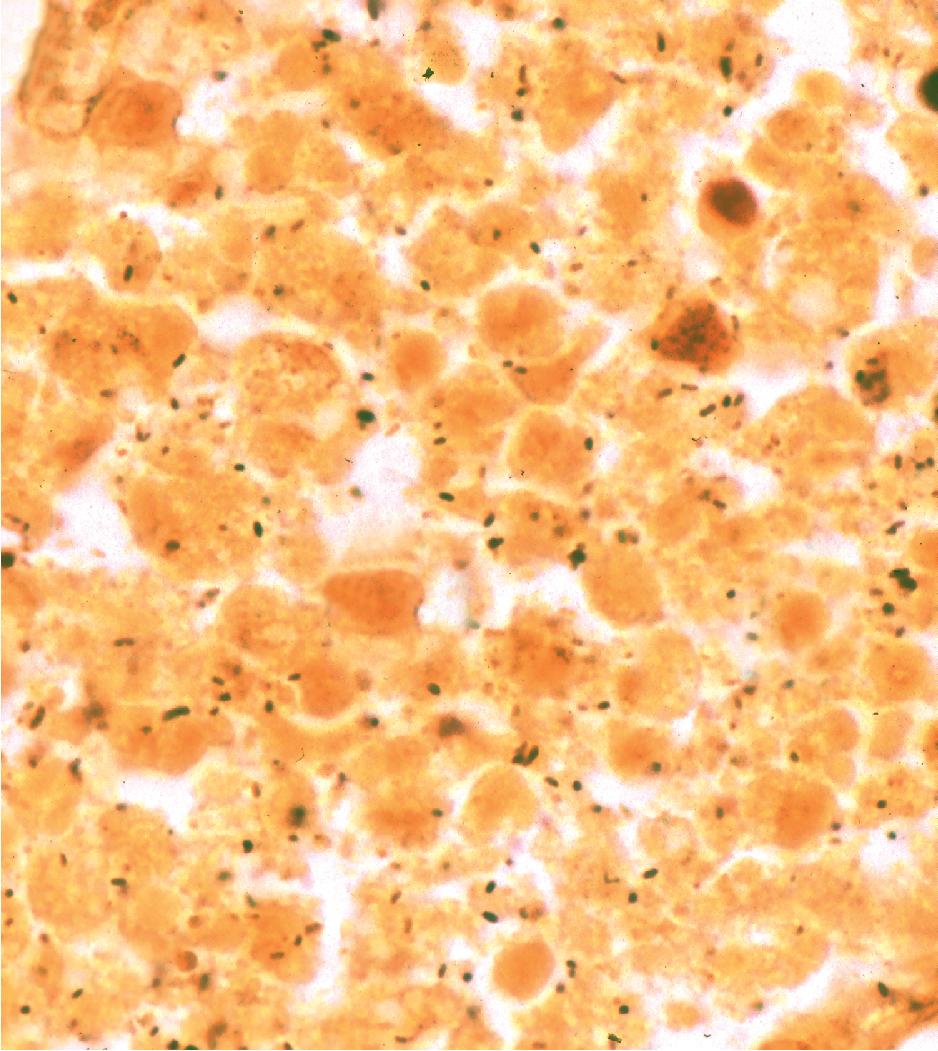
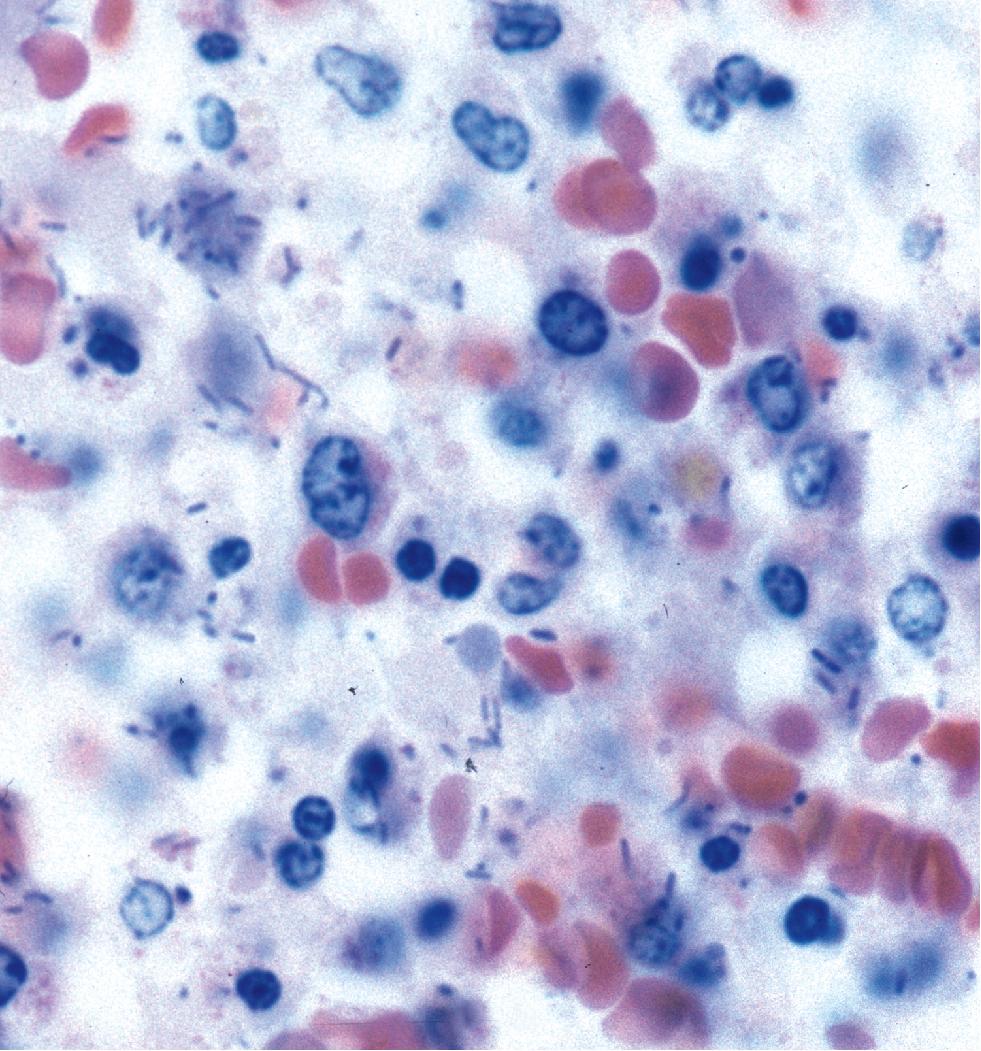
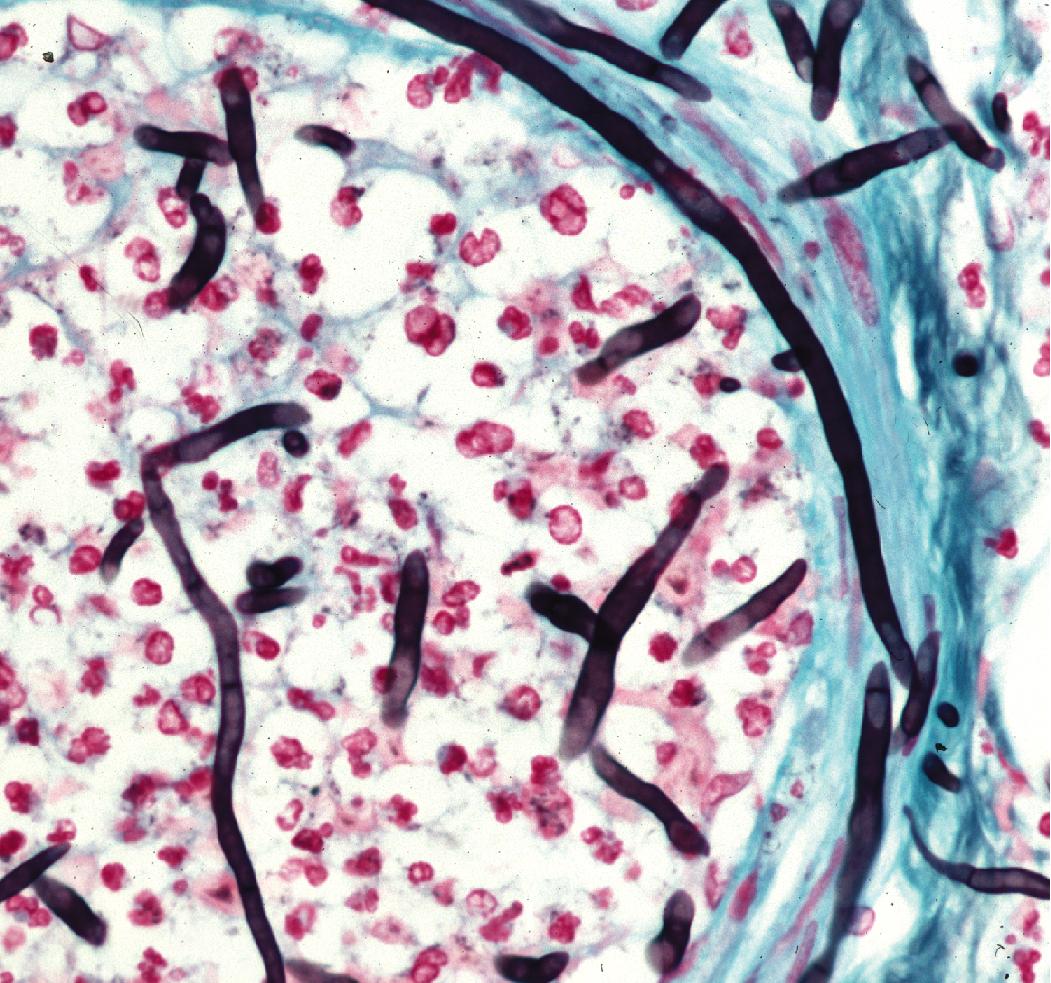
Most mycobacteria stain well with the Ziehl–Neelsen procedure ( Fig. 7.7 ), but the auramine-rhodamine fluorescence procedure is superior in terms of sensitivity ( Fig. 7.8 ). Nocardia organisms, Legionella micdadei , and Rhodococcus equi are weakly or partially acid-fast, and the use of modified acid-fast stains such as the Fite-Faraco technique is more satisfactory for the identification of these organisms. Some mycobacterial species, such as M. avium complex (MAC), are also periodic acid–Schiff reagent (PAS)-positive, GMS-positive, and weakly gram-positive.
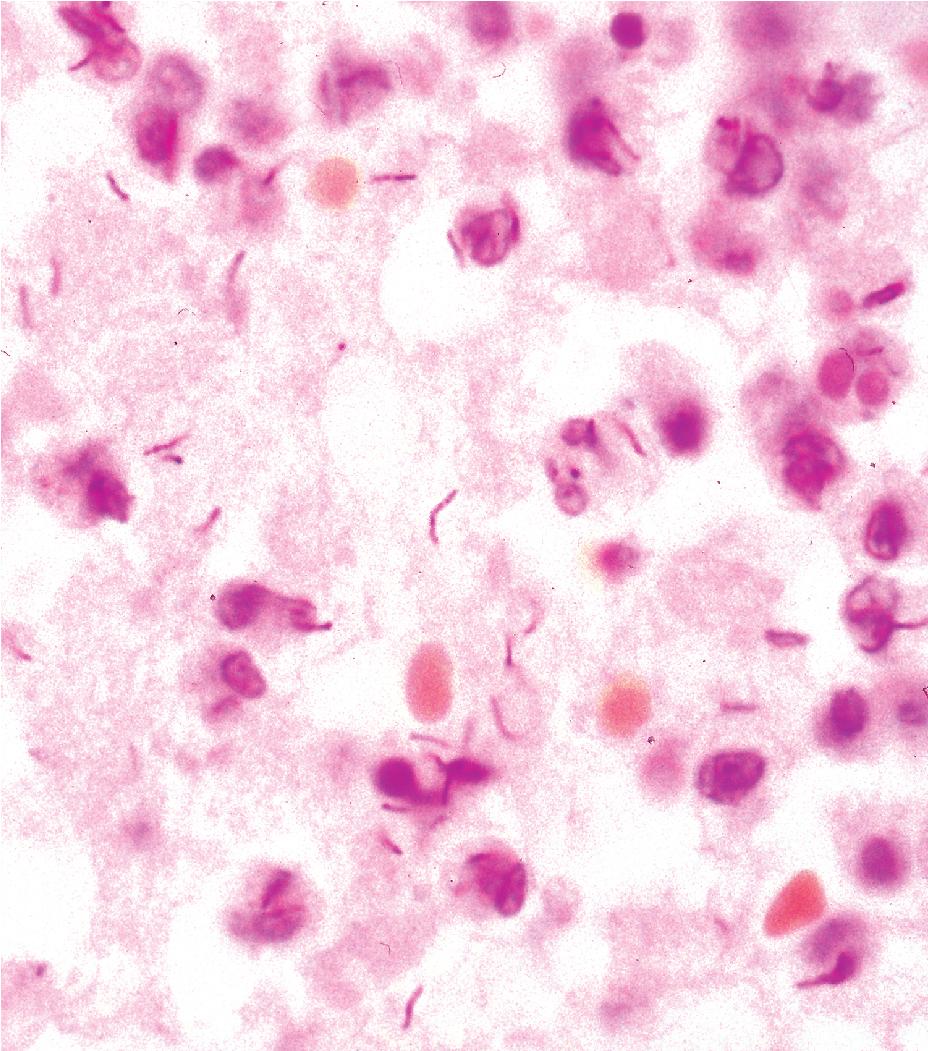
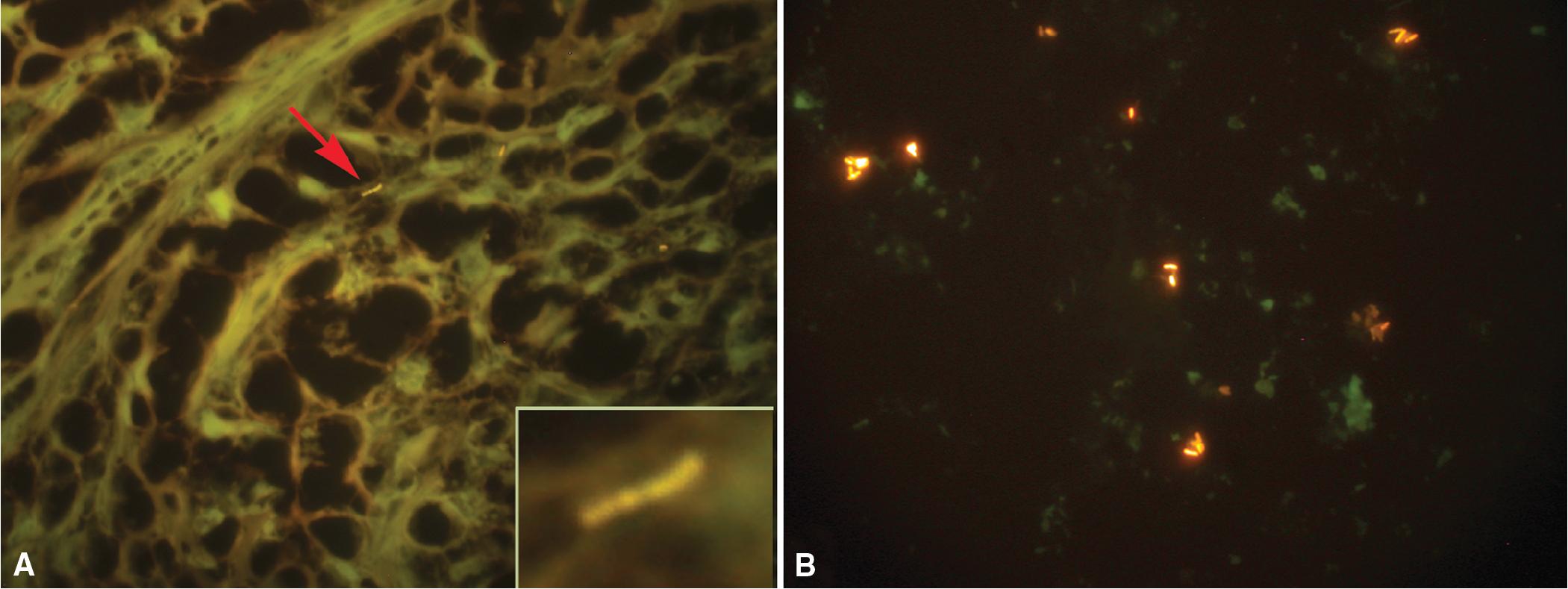
Finally, for the identification of most protozoa and helminths, as well as viral inclusions, a good-quality hematoxylin and eosin (H&E)–stained section suffices; in fact, a well-prepared H&E section alone is diagnostic for many infectious diseases. This stain can often detect and even distinguish between bacterial cocci and bacilli when the burden of organisms is high ( Fig. 7.9 ).
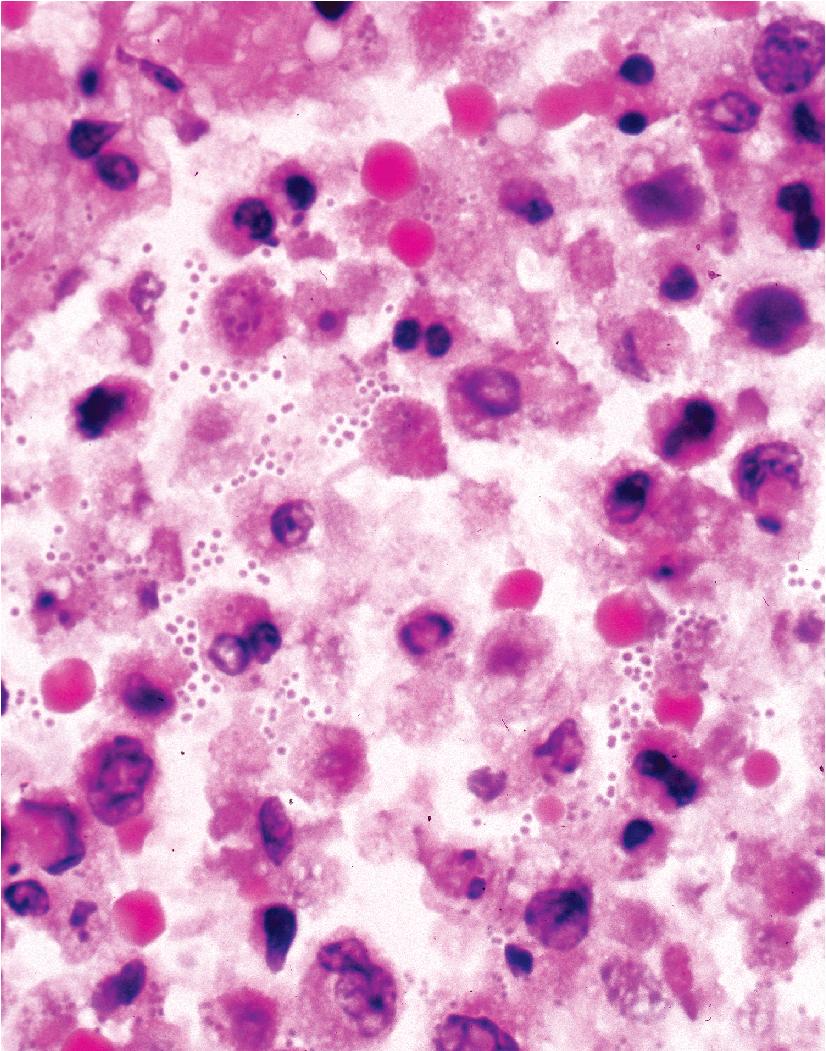
The application of ancillary studies—such as immunohistochemistry, in situ hybridization ( Fig. 7.10 ), or nucleic acid amplification technology—can provide a specific etiologic diagnosis in certain cases. These techniques have the best chance of diagnosing infections caused by fastidious species that are difficult or impossible to culture from fresh samples; they are also useful in situations where only formalin-fixed, paraffin-embedded tissues are available. Immunohistochemical reagents for microbiologic detection are becoming increasingly available and provide added power to determining specific diagnoses on formalin-fixed paraffin-embedded tissue ( Fig. 7.11 ). Although these techniques provide the diagnostic equivalence of culture confirmation, they are not without limitations and diagnostic pitfalls. The polymerase chain reaction (PCR) method first introduced in the 1980s has undergone a number of modifications. Non-PCR DNA amplification methods and methods not based on the amplification of the DNA target per se but on amplification of the signal or probe have also been introduced. Among the more recently available technologies is the rapid-cycle real-time PCR assay, representing an especially powerful advance in that it is significantly more sensitive than culture. The adaptation of various amplification methods to real-time and multiplex formats enables laboratories to detect a wide range of respiratory pathogens. Furthermore, the transition from traditional and analyte-specific methods to more global technologies such as PCR arrays, liquid bead arrays, microarrays, and high-throughput DNA sequencing is underway. Mass spectrometry-based methods for microorganism identification by matrix-assisted laser desorption time-of-flight (MALDI-TOF) are also rapidly revolutionizing the clinical microbiology field and supplanting many conventional methods in larger laboratories. Over time, these methods will find a place in laboratories of all sizes and dramatically impact the speed and accuracy of microbiologic testing practice for all types of microorganisms.
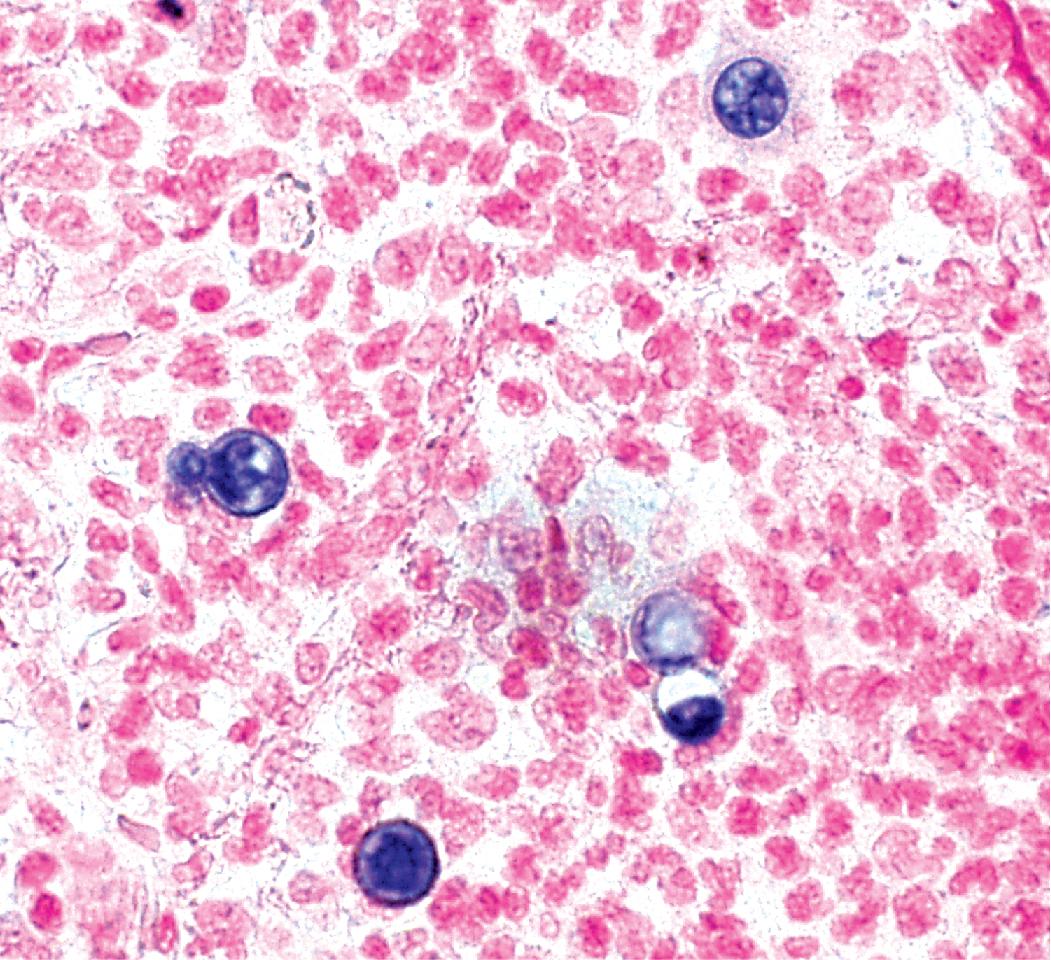
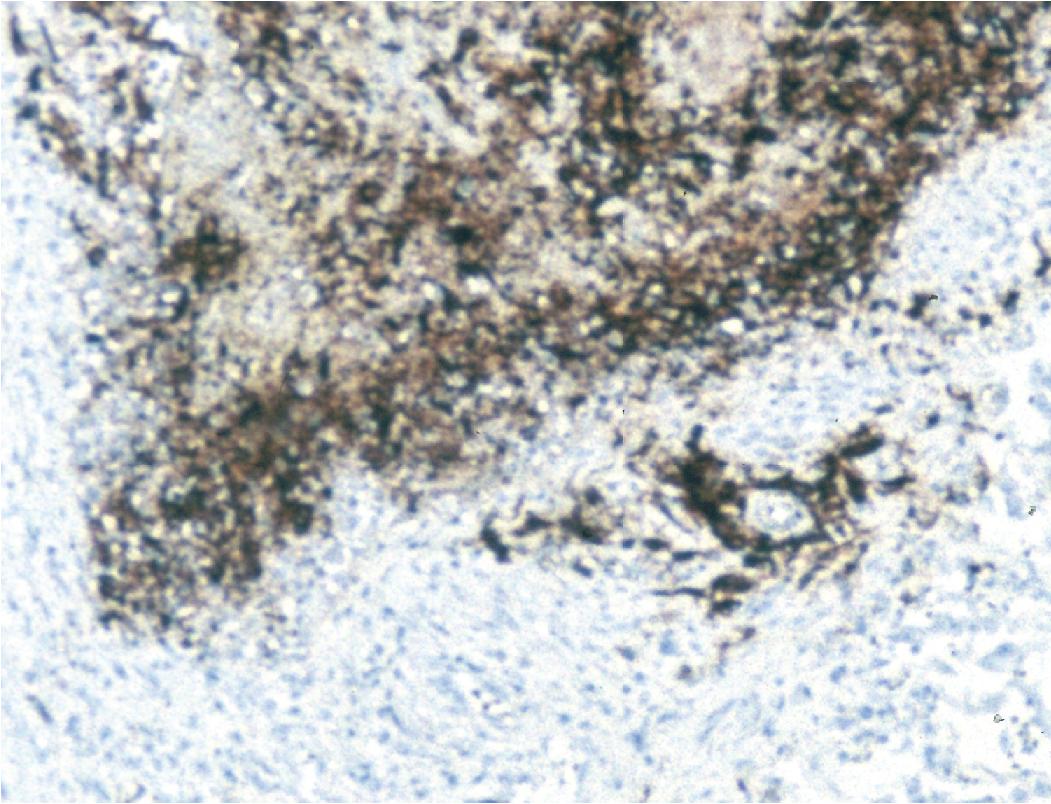
A wide variety of infectious diseases of the lung—including bacterial, mycobacterial, fungal, viral, and parasitic—can be diagnosed through exfoliative or fine-needle aspiration cytologic techniques. Fine-needle aspiration is an especially powerful tool compared with the exfoliative cytology study of respiratory secretions: sputum, bronchial washings/brushings, and bronchoalveolar lavage (BAL) fluid. The usefulness of exfoliative cytology examination is often limited owing to the difficulty of distinguishing colonizing/contaminant organisms in the airways from true pathogens. Nonetheless both diagnostic techniques are complementary and have been used in recent years to evaluate pneumonias and pulmonary nodules in both immunocompetent and immunocompromised patients.
Mass-like infiltrates are often the target of aspiration biopsy needles when suspicion or exclusion of an infectious process ranks high in the differential diagnosis. Besides the morphologic features of the microorganism, important cytologic clues to the diagnosis include the accompanying cellular response and the presence and character of any necrotic debris, as outlined in Table 7.2 . Although nonspecific, such features can suggest certain possibilities to the cytopathologist and assist the microbiology laboratory in triaging the specimen. To this end, the presence of a cytopathologist, microscope, and staining setup during the aspiration process can be useful. The cytopathologist can correlate the clinical setting, radiologic features, and clues from the gross character of the aspirate (color, consistency, odor, etc.), thereby assisting in narrowing the diagnostic possibilities and avoiding false-positive and false-negative diagnoses. Also, immediate evaluation of smears by rapid stain procedures allows the cytopathologist to either make or suggest a specific diagnosis, as with the preparation and evaluation of a frozen section during intraoperative consultation. Smears can be prepared for special stains, needle rinses can be performed for culture and other ancillary studies, and additional aspirations may be encouraged for these purposes. Special stains for bacteria, mycobacteria, and fungi should be used whenever the character of the aspirate and the clinical setting (e.g., compromised immune status) indicate that such studies may be useful.
| Pattern | Possible Etiologic Agent(s) |
|---|---|
| Acute purulent inflammation/abscess | Bacteria, fungi |
| Granuloma pattern (epithelioid cells with or without necrosis): Caseous/necrotizing; suppurative epithelial mixed | Mycobacteria, bacteria, parasites, fungi |
| Foamy alveolar cast pattern | Pneumocystis jirovecii |
| Histiocytic | Mycobacteria, bacteria, fungi |
| Chronic inflammation (lymphocyte and plasma cell) | Virus, other, agent not otherwise specified |
| Null (“id”) reaction | Virus, any, other |
Some interventionists prefer to provide only a needle core biopsy in lieu of an aspirate for a variety of reasons. These two techniques can be viewed as complementary; whereas needle core biopsies work well for neoplasms and many granulomas, the aspirate is often superior for diagnosing many types of infections, especially bacterial abscesses. Sometimes a rapid and specific etiologic diagnosis is possible at the bedside, based on the microscopic features of the organism itself. However, when the organism is not readily apparent or its features are inconclusive, the microbiology laboratory can be invaluable for its role in isolation and identification. BAL, typically performed in the evaluation of infection in an immunocompromised host, provides a standard panel of microbiology results, which should always be correlated with the cytology findings. ,
The surgical pathologist rarely receives a biopsy from a patient with community-acquired or nosocomial pneumonia. Most of these infections are suspected clinically by symptoms and physical and radiologic findings; some are confirmed immediately on respiratory secretions using the Gram stain (or later by culture) in the microbiology laboratory. Serologic studies sometimes prove to be diagnostic. Even when conventional microbiologic approaches are applied, approximately 50% of bacterial pneumonias remain undiagnosed in the laboratory. Patients with mild disease are often not tested and treated empirically with antibiotic regimens following established guidelines. By contrast, patients with severe disease, whether immunocompromised or not, often become candidates for invasive procedures.
Bacterial pneumonia may be classified according to various parameters including pathogenesis, epidemiology, anatomic pattern, clinical course, and organism type. For anatomic pathologists the pattern of disease under the microscope is the critical starting point. For example, the majority of bacterial infections are pyogenic (neutrophil-rich) and therefore correspond to alveolar filling (pattern 4), while aspiration-related infections tend to produce nodular disease (pattern 5) with micro- or macro-nodular abscesses. A natural overlap exists between acute injury (pattern 1) and alveolar filling (pattern 4) as acute diseases in the lung become organizing pneumonia over time. The spectrum of bacterial organisms responsible for lung infections is broad. The most common are presented in Table 7.3 , subdivided by route and circumstance of delivery to the lung.
| Community acquired |
|
| Nosocomial |
|
| Agents of bioterrorism |
|
Bacterial lung injury patterns will vary in accordance with the virulence of the organism and the host response. Here we will focus on the most common patterns. As mentioned, expected overlap occurs based on the natural evolution of lung injury. Acute injury becomes subacute organizing pneumonia, and depending on the resolution of the infection, persistent localized disease (nodules) may result in the form of a granuloma or abscess.
Acute exudative pneumonia is most often caused by pyogenic bacteria, such as streptococci, which typically produce a neutrophil-rich intraalveolar exudate (i.e., alveolar filling) with variable amounts of fibrin and red cells. Pathologists recognize this constellation of findings as acute lobar pneumonia ( Fig. 7.12 ), which usually correlates with patchy segmental infiltrates on the chest film (consolidation pattern on HRCT).
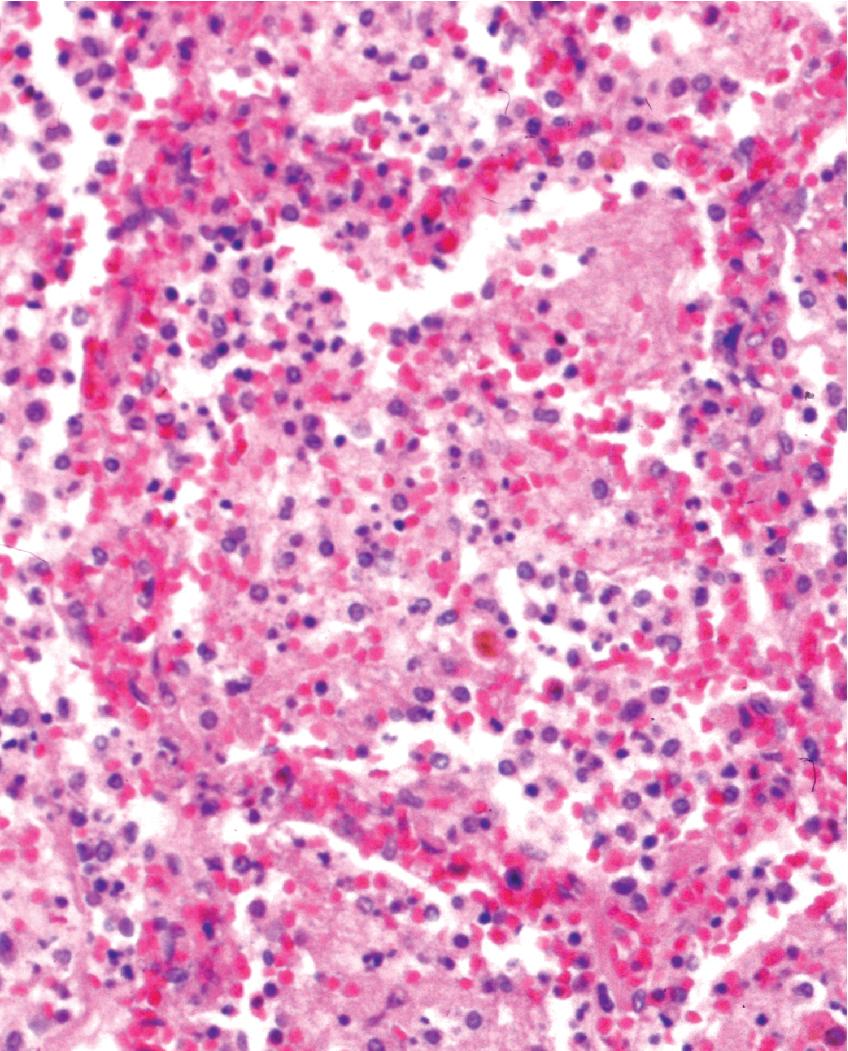
With increasing organism virulence and disease severity, lobular exudates may become confluent (i.e., lobar pneumonia). In milder cases, the disease may be limited to the airways (bronchitis/bronchiolitis) with a mixed cellular infiltrate of mononuclear cells and neutrophils ( Fig. 7.13 ). One very common manifestation of such airway-limited infection has been designated as acute exacerbation of chronic obstructive pulmonary disease (COPD). A majority of these exacerbations are caused by particular bacteria (specifically Haemophilus influenzae , Streptococcus pneumoniae , and Moraxella catarrhalis ) with approximately one-third resulting from viral airway infections, typically resulting from rhinovirus, respiratory syncytial virus (RSV), and human metapneumovirus.
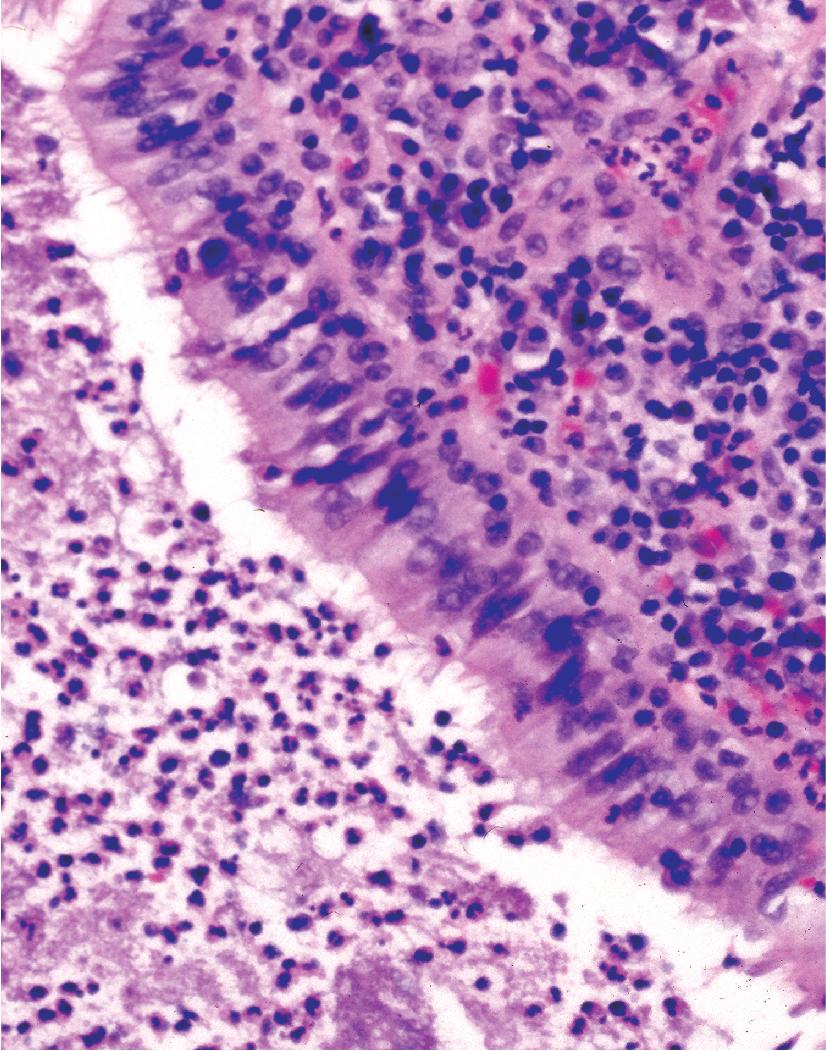
Nodular inflammatory infiltrates with or without necrotizing features ( Fig. 7.14 ) are characteristic of infection by certain species, such as R. equi ( Fig. 7.15 ). Necrotizing pneumonias may also be produced by pyogenic bacteria such as Streptococcus aureus , Streptococcus pyogenes , and the gram-negative bacilli— Klebsiella , Acinetobacter , Pseudomonas , and Burkholderia species.
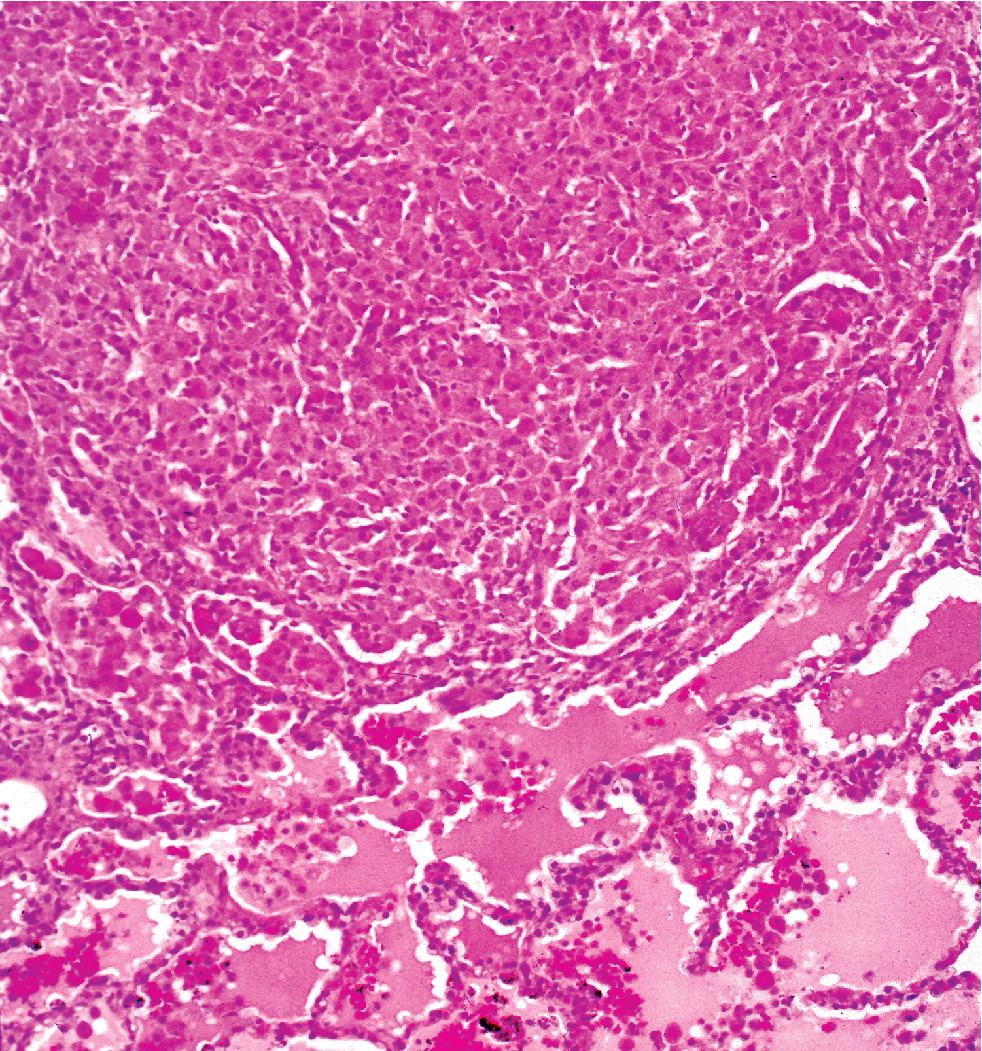
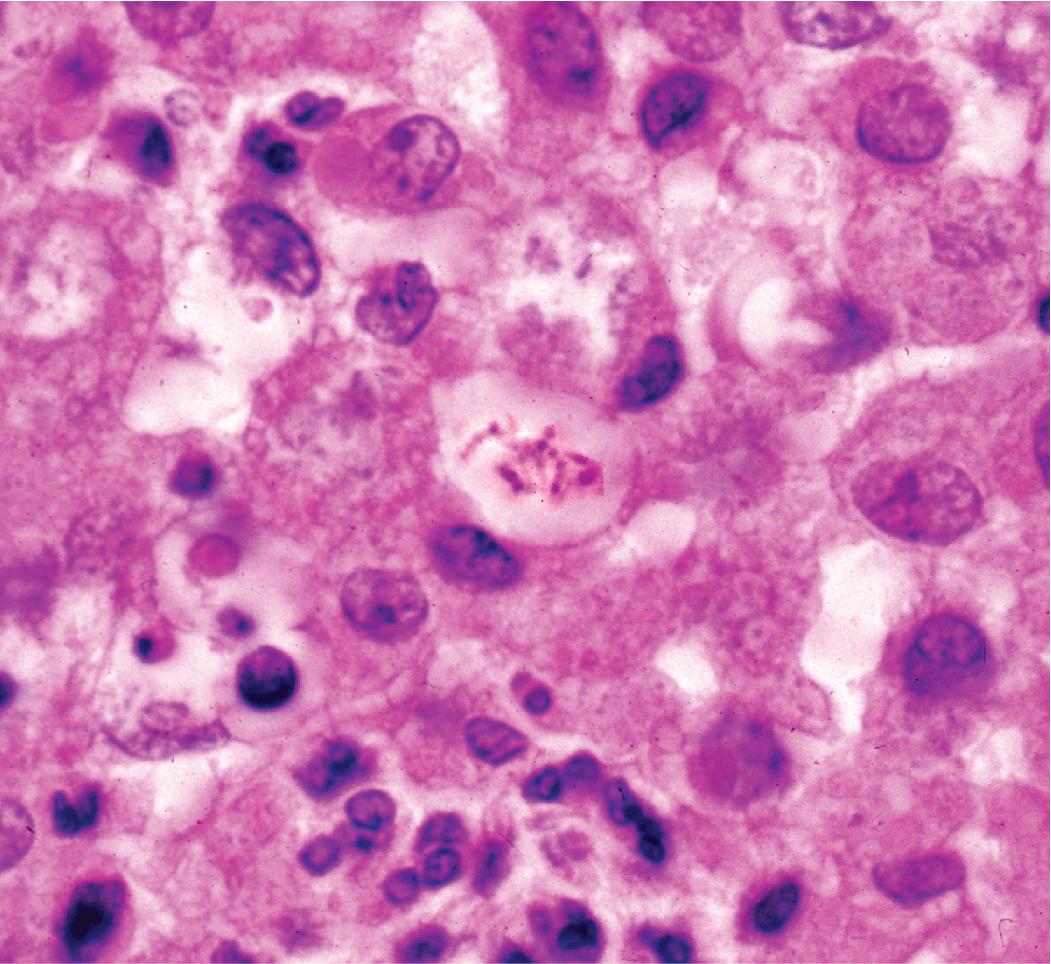
A subset of the nodular histopathologic pattern, miliary infection ( Fig. 7.16 ), strongly implies pneumonia secondary to the hematogenous spread of bacteria (septicemia). This pattern of infection can be seen with other organisms, such as Nocardia and the anaerobic Actinomycetes . In these settings, histopathologic examination may show a combination of both nodular disease and alveolar filling.
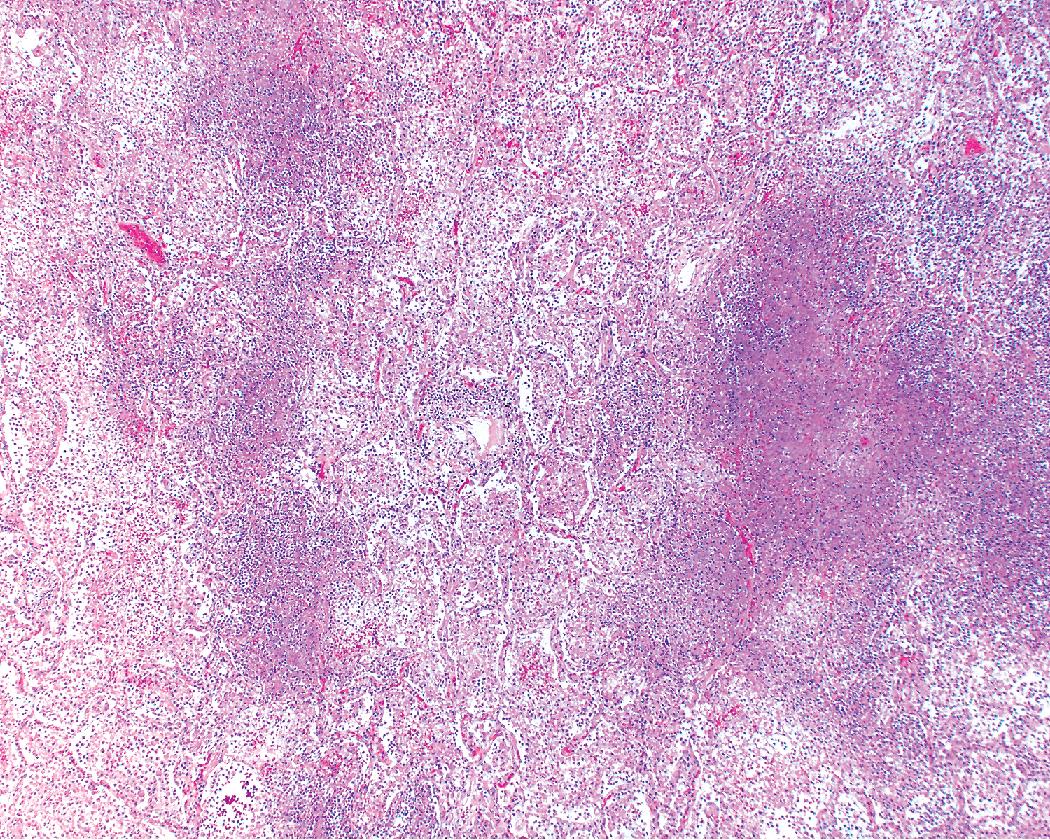
There are multiple scenarios for aspiration pneumonia, including cases caused by chemical pneumonitis (so-called Mendelson syndrome), airway obstruction, exogenous lipoid pneumonia, chronic interstitial fibrosis, diffuse bronchiolar disease, bacterial pneumonia, and lung abscess. , Aspiration pneumonia refers specifically to the aspiration of bacteria in oropharyngeal secretions, with the bacterial species depending on whether the aspiration event occurs in the community or hospital setting. Recognition of food particles (so-called pulses) is important in diagnosis. These may or may not be invested by giant cells but are usually found in purulent exudate or granulomatous foci. In the organizing phase of the pneumonia, food particles may be found within polyps of organizing pneumonia in the alveolar ducts and alveoli. Lobular pneumonia, lipoid pneumonia, organizing pneumonia, and bronchiolitis, alone or in combination, may also be seen. , The pathogens in lung abscess ( Fig. 7.17 ) usually encompass a polymicrobial mixture of aerobic and anaerobic bacteria, and formation of such abscesses most often is secondary to aspiration ( Fig. 7.18 ). Infections due to Actinomyces species ( Fig. 7.19 ) and Nocardia species may also manifest this pattern, as can those infections caused by certain pyogenic bacteria, such as S. aureus and other organisms listed previously for necrotizing pneumonias. Granulomatous inflammation with foreign bodies may be present if aspiration is the cause ( Fig. 7.20 ).
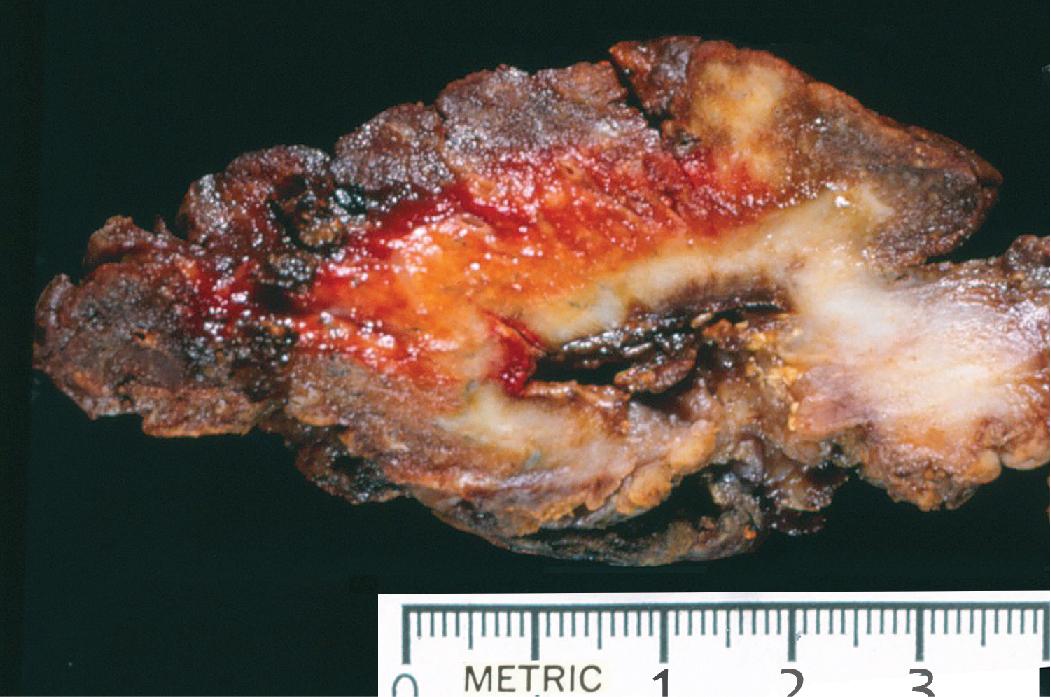
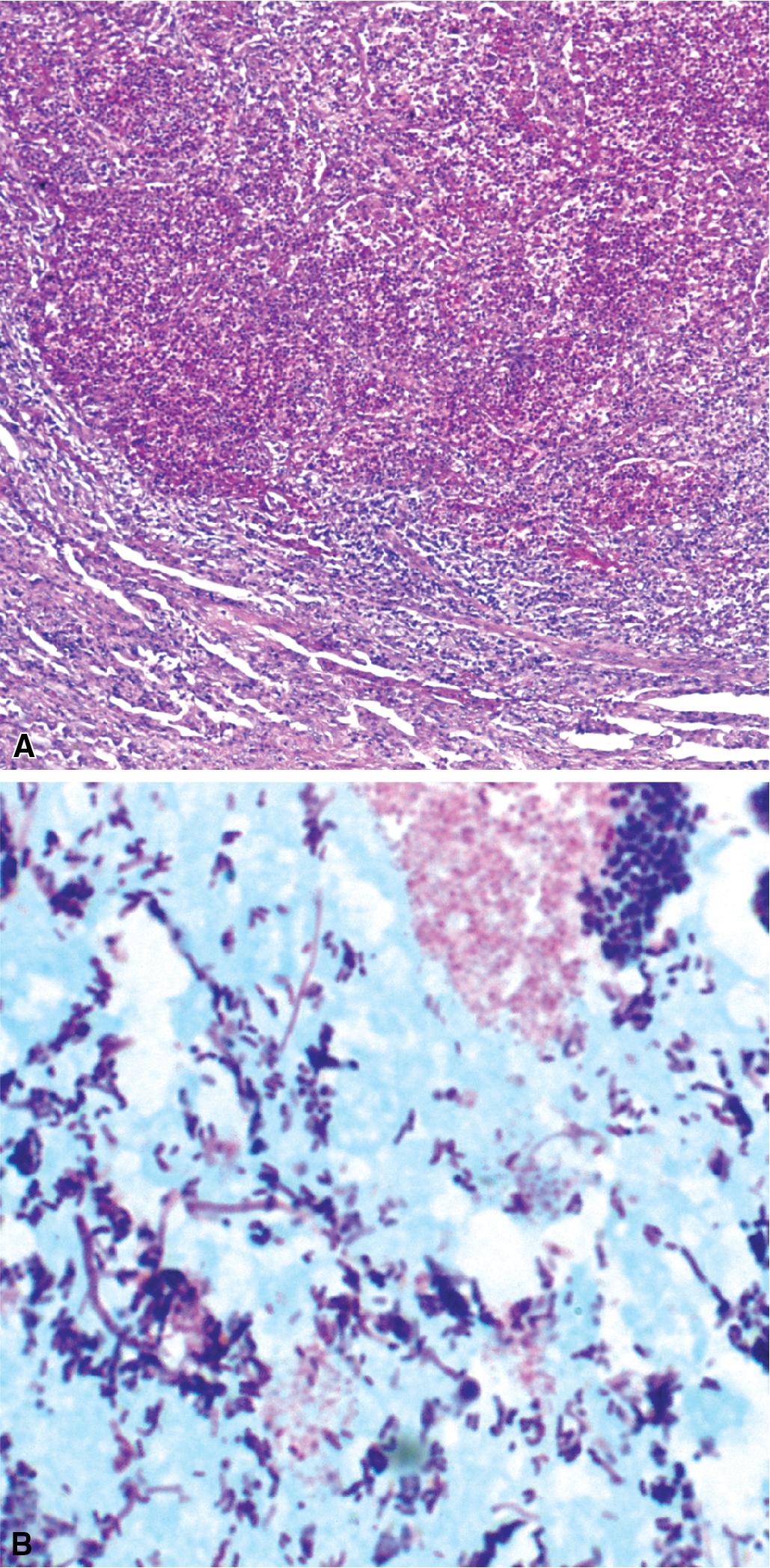
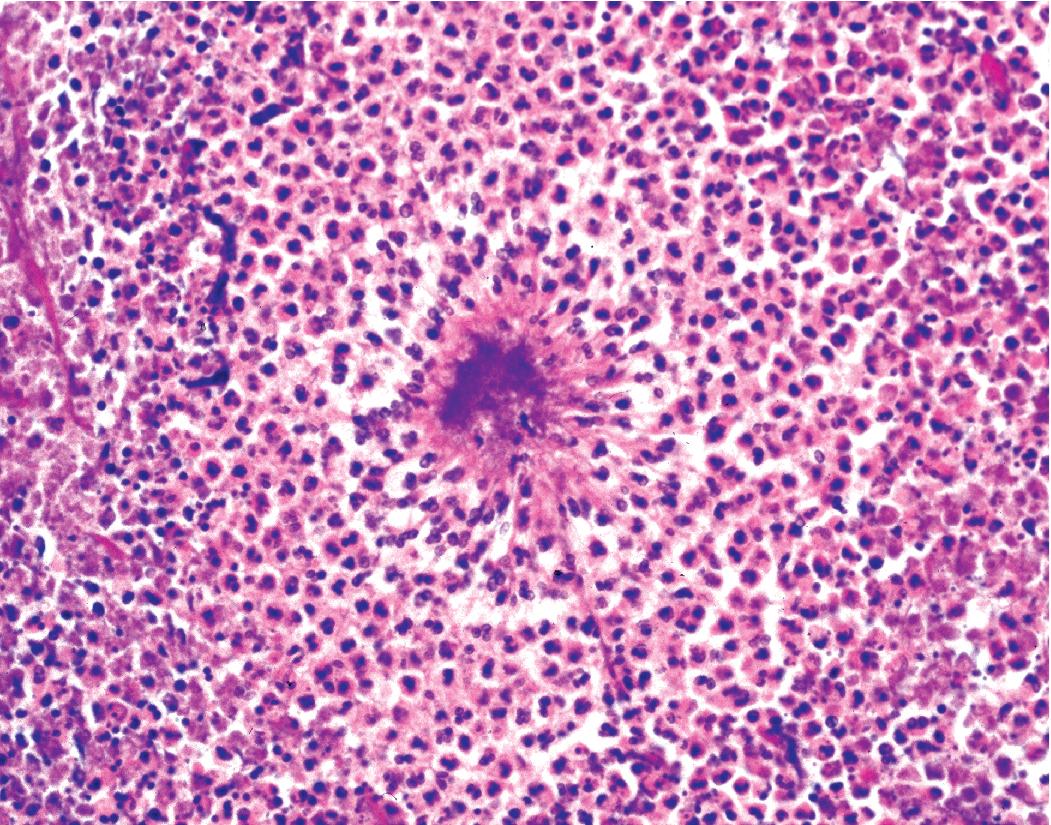
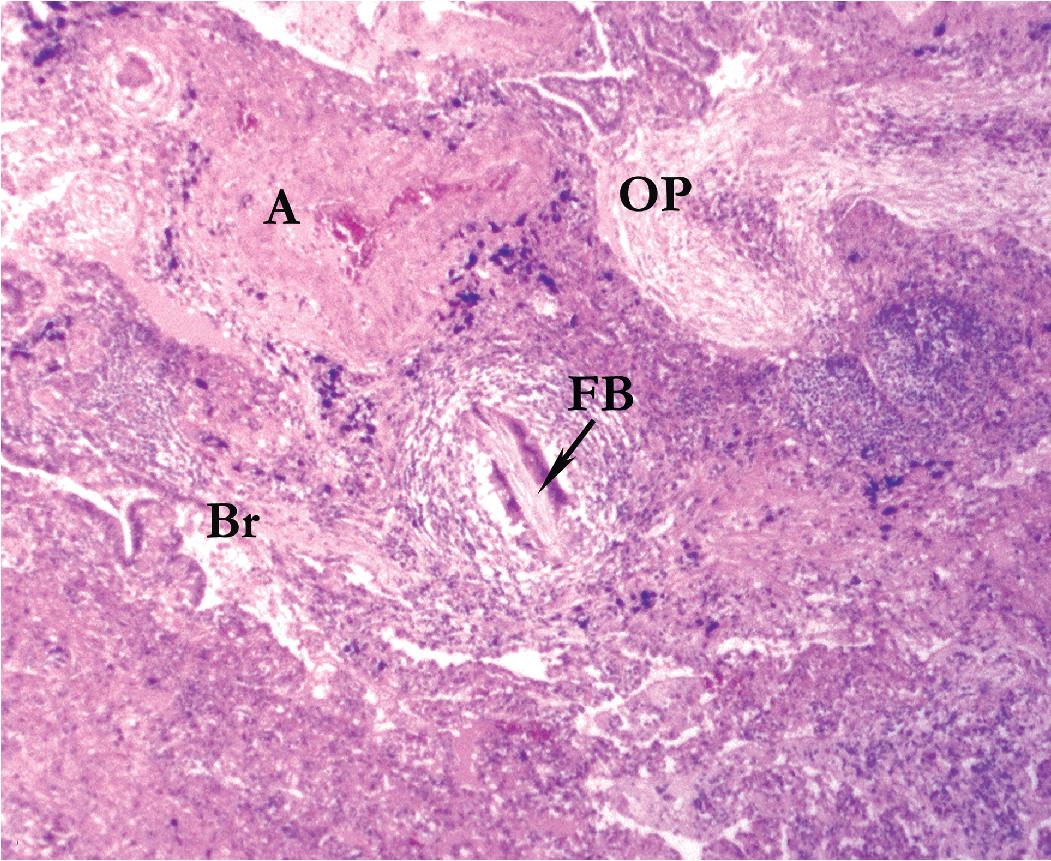
Chronic bacterial infections ( Fig. 7.21 ) that are slow to resolve as a result of inappropriate initial therapy, involvement with certain microbial species, a noninfectious comorbid process, or an inadequate host response can produce a nonspecific fibroinflammatory pattern, with lymphoplasmacytic infiltrates, macrophages, or organization with polyps of immature fibroblasts in alveolar ducts and alveolar spaces. If not resorbed, polyps of airspace organization may become polyps of intraalveolar fibrosis, which sometimes ossify (dendriform ossification). Such scarring in chronic pneumonia is often associated with localized interlobular septal and pleural thickening ( Fig. 7.22 ), producing a jigsaw puzzle pattern of scarring best seen at scanning magnification.
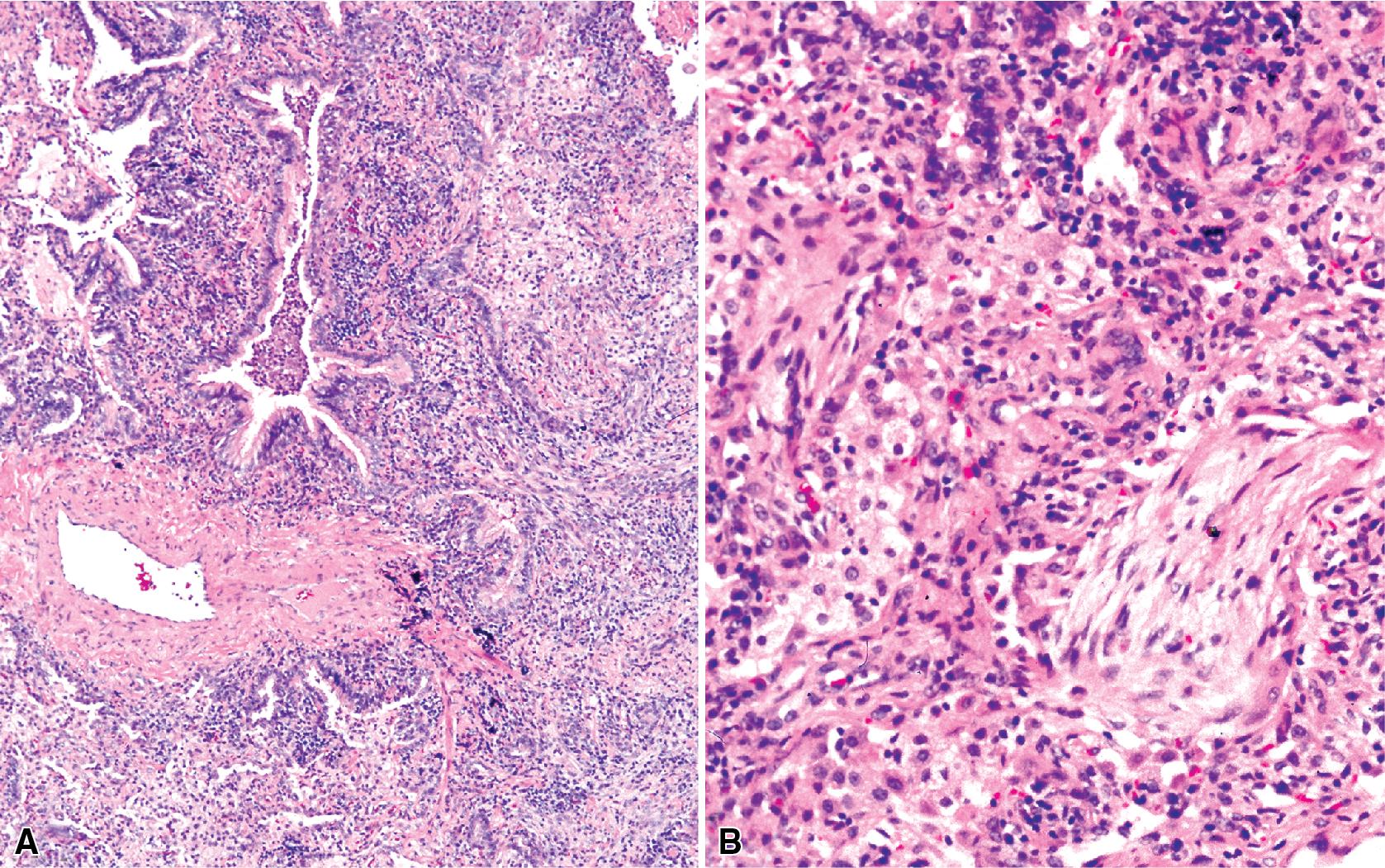
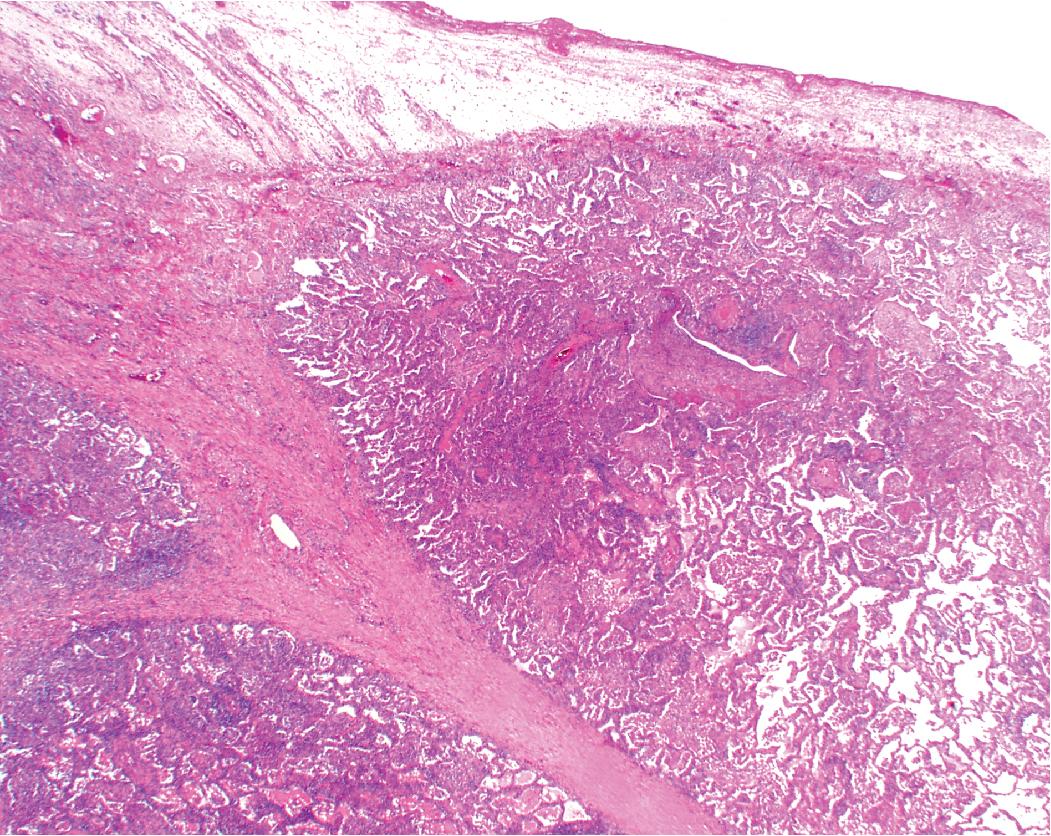
Diffuse alveolar damage is the histopathologic correlate of the acute respiratory distress syndrome (ARDS), and today lung infection is the leading cause of diffuse alveolar damage and ARDS in the United States. Diffuse alveolar damage may coexist with any of the necroinflammatory patterns described earlier. The initial exudative phase of this ARDS is accompanied by hyaline membranes ( Fig. 7.23 ), the later organizing phase by airspace and interstitial fibroplasia. In clinical practice, diffuse alveolar damage accompanied by tissue necrosis is nearly always a manifestation of lung infection.
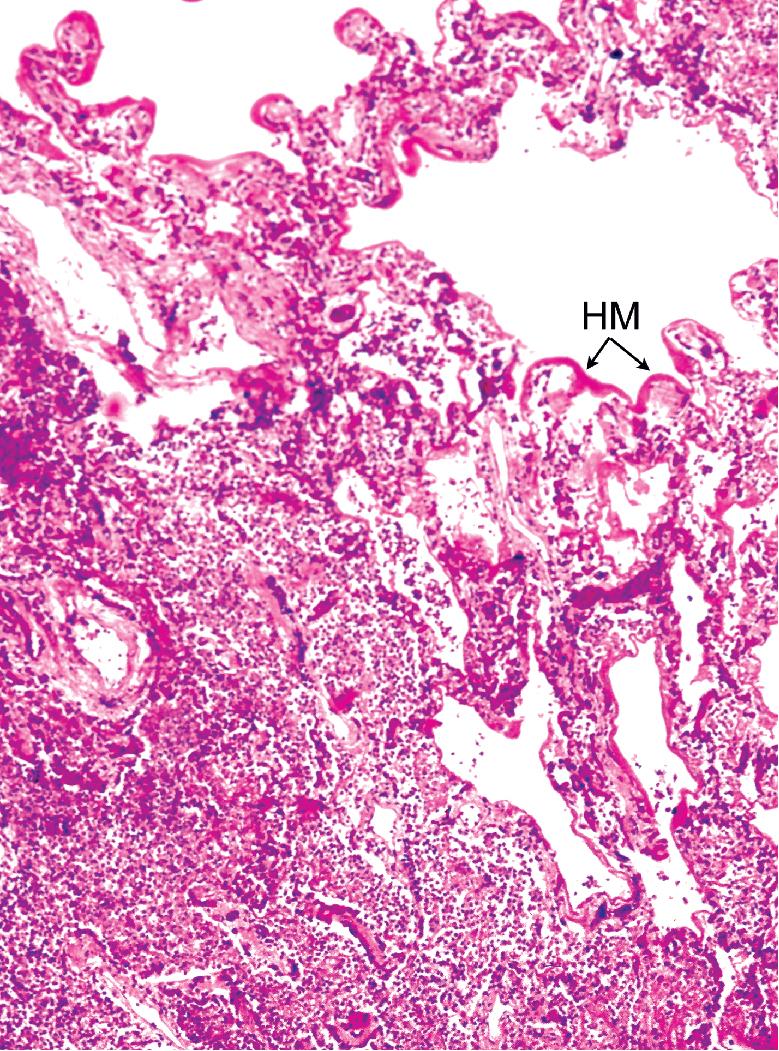
The atypical pneumonias include the well-described cases due to Legionella species and the less well-described cases caused by other organisms comprising the atypical group. Legionella infection typically results in an intensely neutrophilic acute fibrinopurulent lobular pneumonia ( Fig. 7.24 A). , Legionella bacilli can be identified in silver impregnation-stained sections (see Fig. 7.24 B) or recovered in culture, but newer diagnostic methods, such as real-time PCR and in situ hybridization ( Fig. 7.25 ), can also be applied when standard approaches fail. The histopathologic patterns associated with the other members of the atypical group (i.e., Chlamydia , Mycoplasma ) are not well characterized, mainly because investigation of these pneumonias rarely includes biopsy. The few well-documented cases of Mycoplasma , Chlamydia , and Coxiella infections resemble viral bronchitis or bronchiolitis, with mixed inflammatory infiltrates in airway walls and in the adjacent interstitium ( Fig. 7.26 ). , Relative sparing of the peribronchiolar alveolar spaces has been described, although patchy organized fibrinous exudates are seen in some cases and complications may superimpose additional findings.
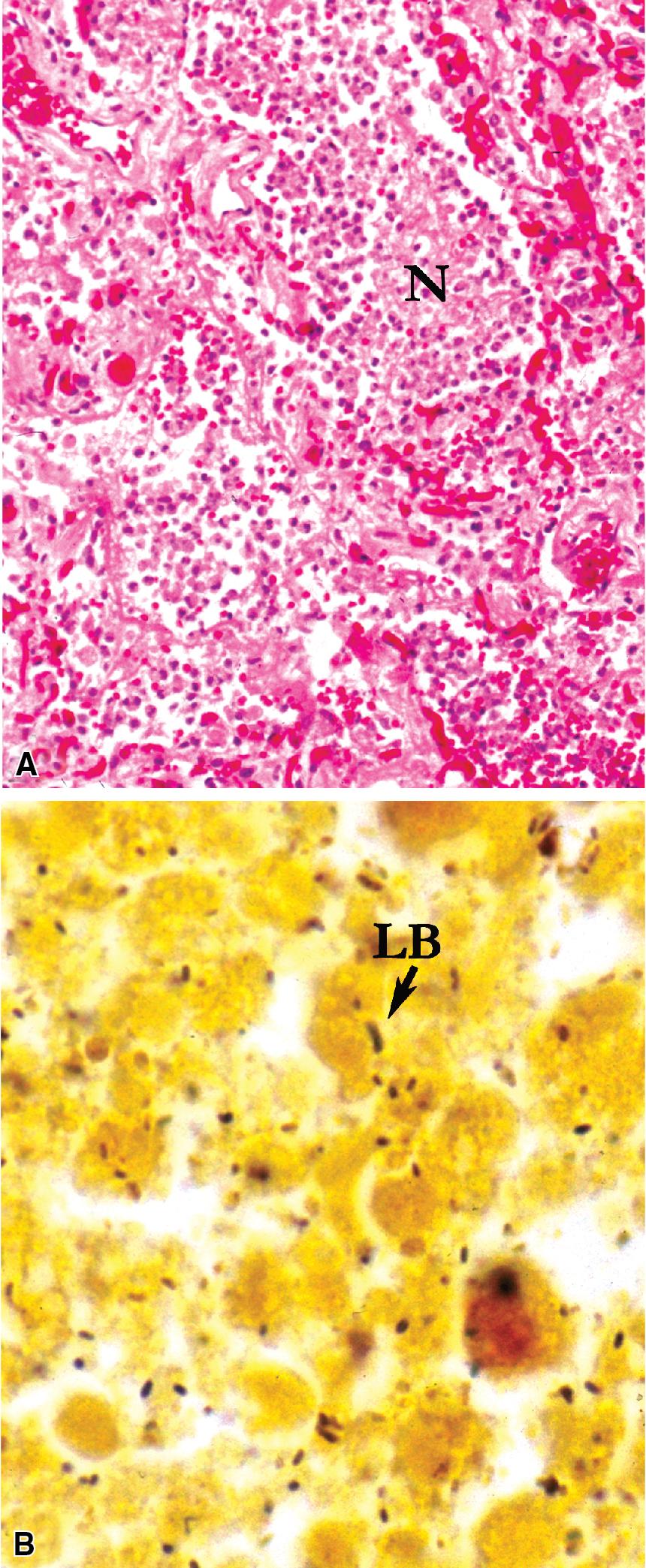
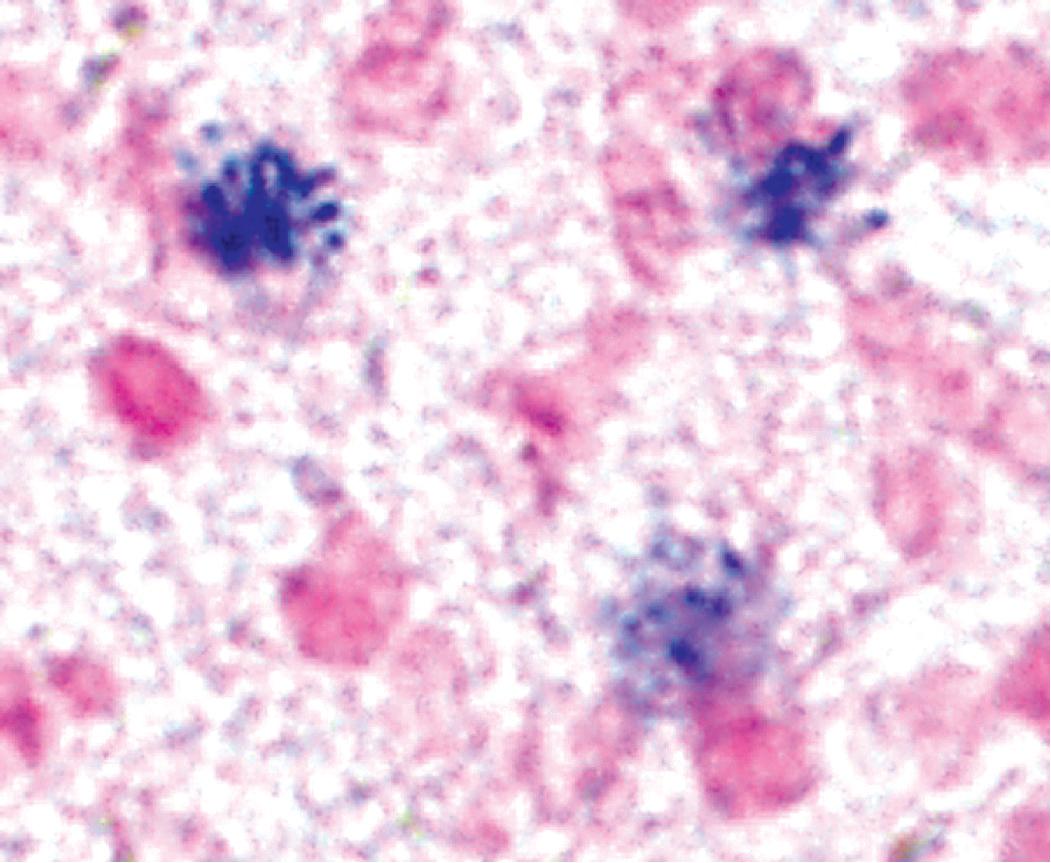
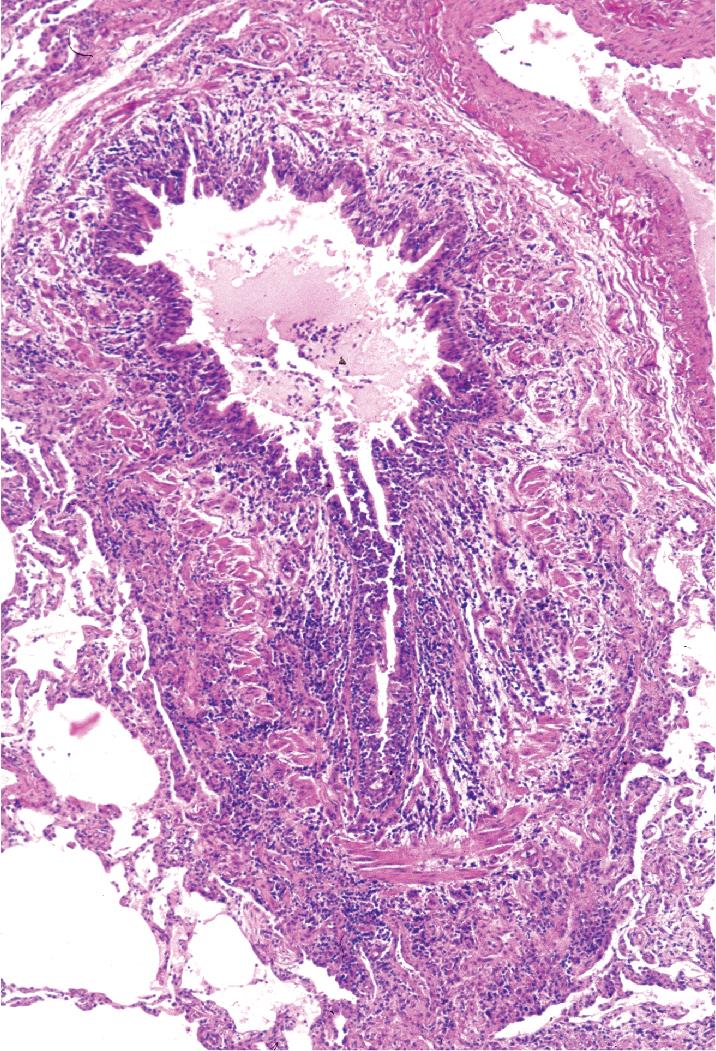
The grains and granules formed by the Actinomycetes and bacteria of botryomycosis may have a uniform tinctorial hue on routine H&E–stained sections, but sometimes these bacterial aggregations display a distinctive body with a hematoxylinophilic core and an outer investment of eosinophilic material; formation of this array is referred to as the Splendore-Hoeppli phenomenon ( Fig. 7.27 ). Actinomycetes species tend to form similar-appearing granules, and both they and the bacteria of botryomycosis are typically found in the midst of purulent exudates. Nocardia species may aggregate in colonies simulating granules, but with a much looser texture ( Fig. 7.28 ) and more monochromatic tinctorial properties. Rarely, these colonies may be identical in appearance to the grains or granules of botryomycosis or actinomycosis in H&E sections.
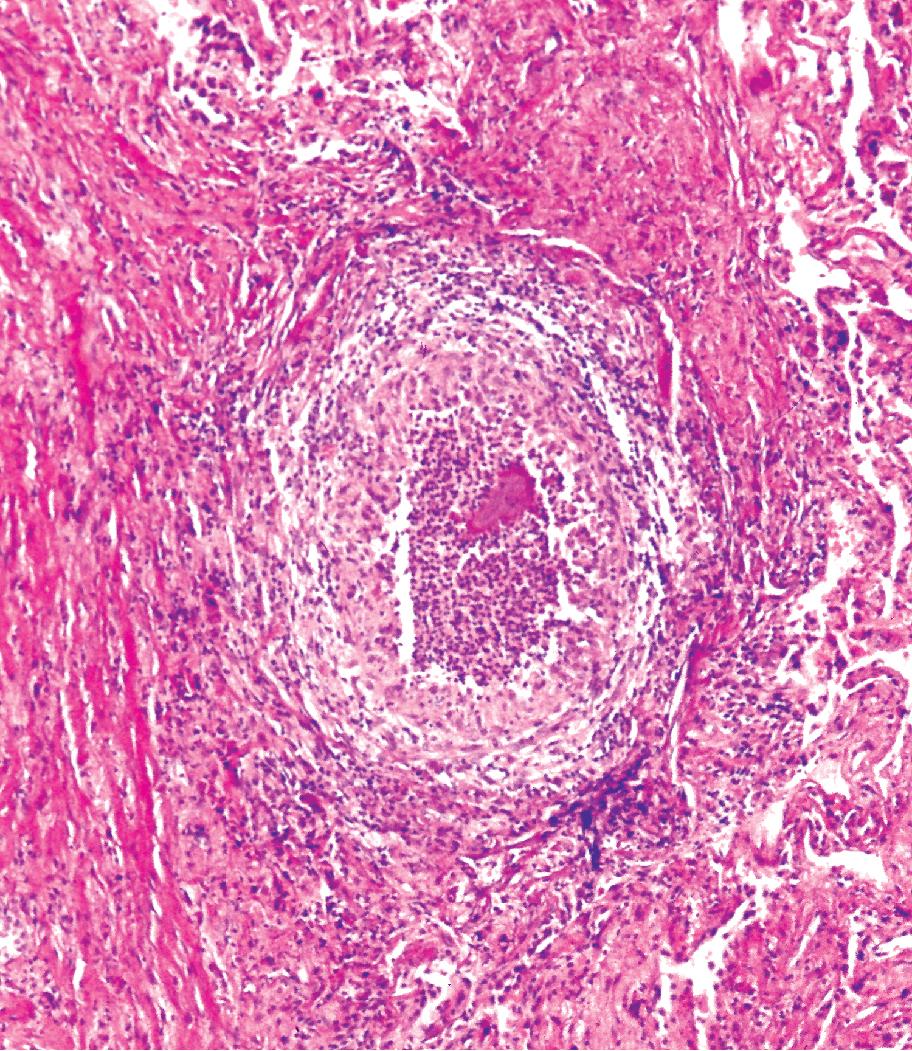
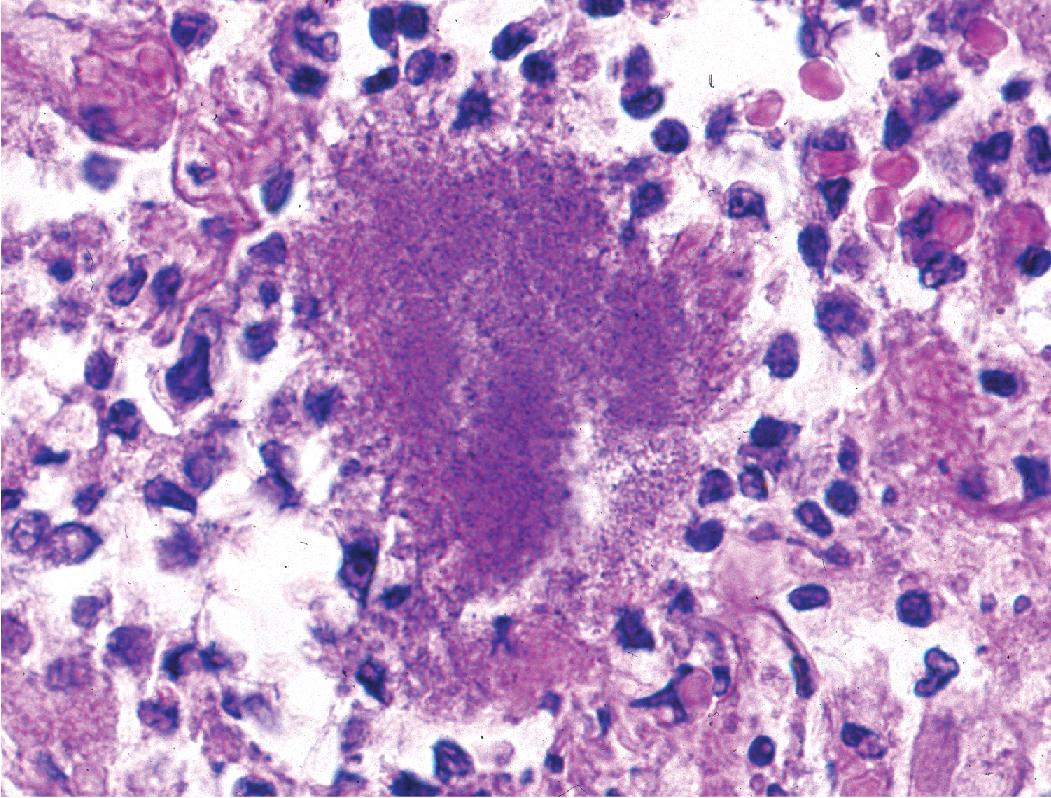
The potential for use of microbial pathogens as agents of bioterrorism requires that clinicians be alert to this possibility when community-acquired pneumonias are found to be caused by these agents. In turn, pathologists must become familiar with the histopathologic features these agents can produce. Respiratory disease caused by the inhalation of Bacillus anthracis , Yersinia pestis , and Francisella tularensis is especially pertinent in this context and is discussed next.
In 1877, Robert Koch’s conclusive demonstration that B. anthracis was the etiologic agent of anthrax revolutionized medicine by linking microbial cause and effect. Inhalational anthrax causes a severe hemorrhagic mediastinitis. This pathologic process in combination with the toxemia ( B. anthracis produces an exotoxin with three potent components—protective antigen, lethal factor, and edema factor) from the ensuing massive bacteremia severely compromises pulmonary function, leading to death in 40% or more of the cases. Pleural effusion may be present, but pneumonia generally is minor and secondary. In those patients in whom pulmonary parenchymal changes are found, the alveolar spaces contain a serosanguineous fluid with minimal fibrin deposits and some mononuclear cells but few if any neutrophils. Large gram-positive bacilli (some may appear partially gram negative) without spores pervade the alveolar septal vessels, with a few in the alveolar spaces. This distribution suggests hematogenous rather than airway acquisition. Hemorrhagic mediastinitis in a previously healthy adult is essentially pathognomonic for inhalational anthrax. The lymph node parenchyma generally is teeming with intact and fragmented gram-positive bacilli, which can be identified as B. anthracis by immunohistochemical studies. , Cultures of blood and pleural fluid, if available, are likely to yield the earliest positive diagnostic results. Sputum studies are much less useful in this regard. Specific guidelines for pathology and microbiology specimens for anthrax diagnosis (as well as other potential agents of bioterrorism) are current and available on the Centers for Disease Control and Prevention (CDC) website.
Primary pneumonic plague follows inhalation of Y. pestis bacilli in a potential bioterrorism scenario. , The infection begins as bronchiolitis and alveolitis that progress to a lobular and eventual lobar consolidation. The histopathologic features evolve over time, beginning with a serosanguineous intraalveolar fluid accumulation with variable fibrin deposits ( Fig. 7.29 ), progressing through a fibrinopurulent phase, and culminating in a necrotizing lesion. The presence of myriad bacilli in the intraalveolar exudates with significantly fewer organisms in the interstitium (a characteristic of primary pneumonia) is one of several pulmonary and extrapulmonary features used to distinguish primary from secondary pneumonic plague. These bacilli may be obvious in H&E-stained sections ( Fig. 7.30 ) but generally are better visualized with Giemsa rather than Gram stain. Immunohistochemical staining provides a rapid and specific diagnosis. In contrast to inhalational anthrax, sputum Gram stain and culture are useful tests that are likely to yield a positive result at clinical presentation. Also, because sepsis is an integral component of the pneumonia, it is important to collect blood culture specimens.
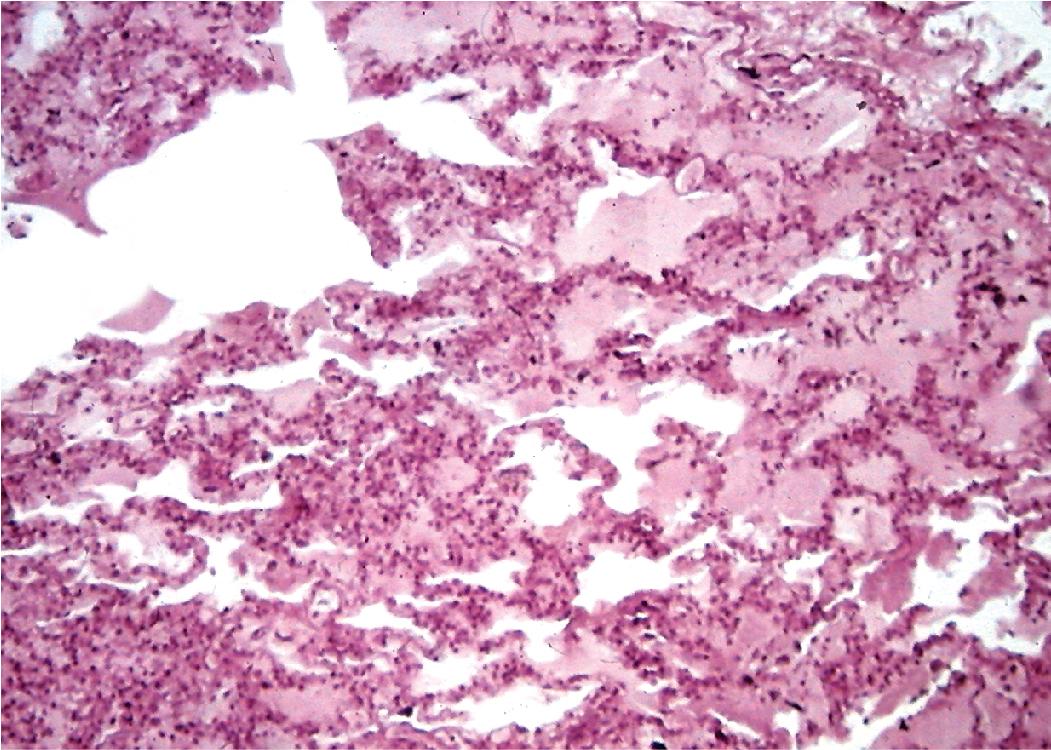
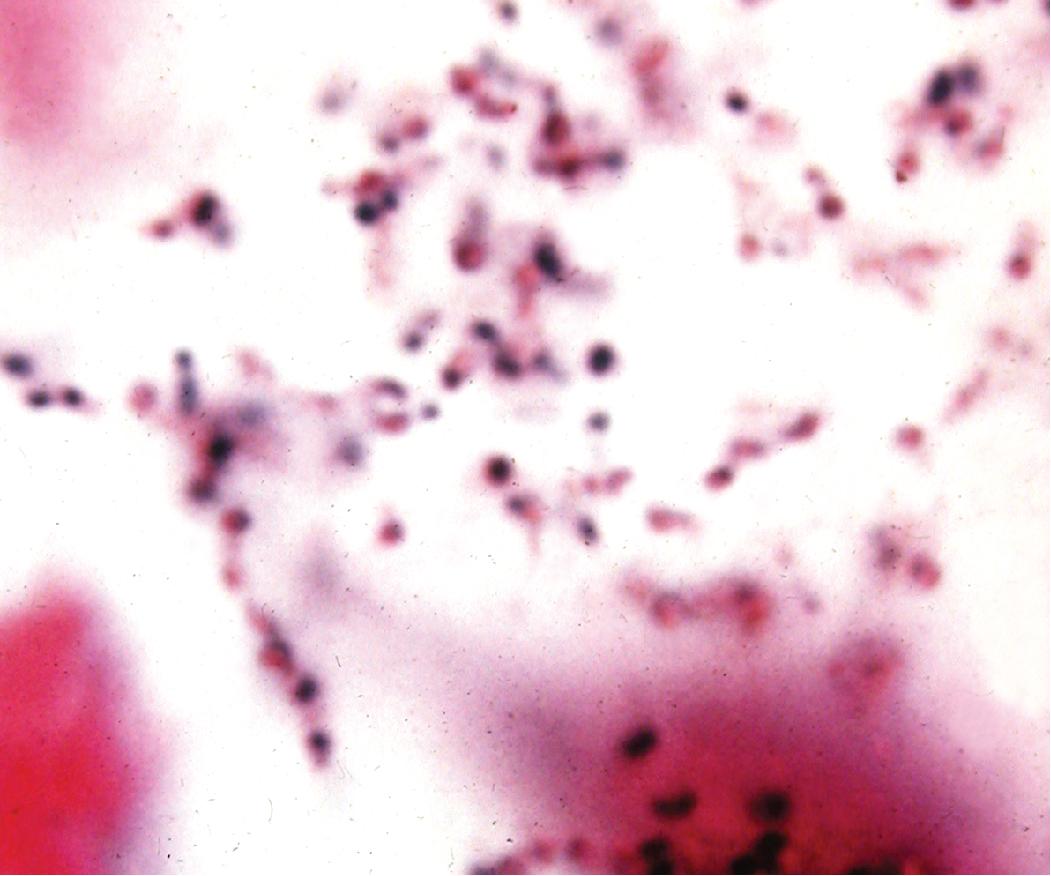
Inhalation of F. tularensis bacilli following a bioterrorism aerosol release is generally expected to result in a slowly progressing pneumonia with a lower case-fatality rate than with either inhalational anthrax or plague. , Initially a hemorrhagic and ulcerative bronchiolitis is followed by a fibrinous lobular pneumonia with many macrophages but relatively few neutrophils ( Fig. 7.31 ). Necrosis then supervenes and evolves into a granulomatous reaction. The small, gram-negative coccobacillary organisms are difficult to identify in a tissue Gram stain, and the use of silvering techniques (e.g., Steiner, Dieterle, Warthin-Starry) is required to enhance their silhouette. Specific fluorescent antibody testing for formalin-fixed tissue and immunohistochemical studies are available through public health laboratories. In the microbiology laboratory, Gram stain and culture of respiratory secretions are useful for diagnosis, but blood cultures are often negative. Antigen detection and molecular techniques, such as PCR amplification, can also identify F. tularensis . Serologic tests are available but probably would not provide timely information in an outbreak situation.
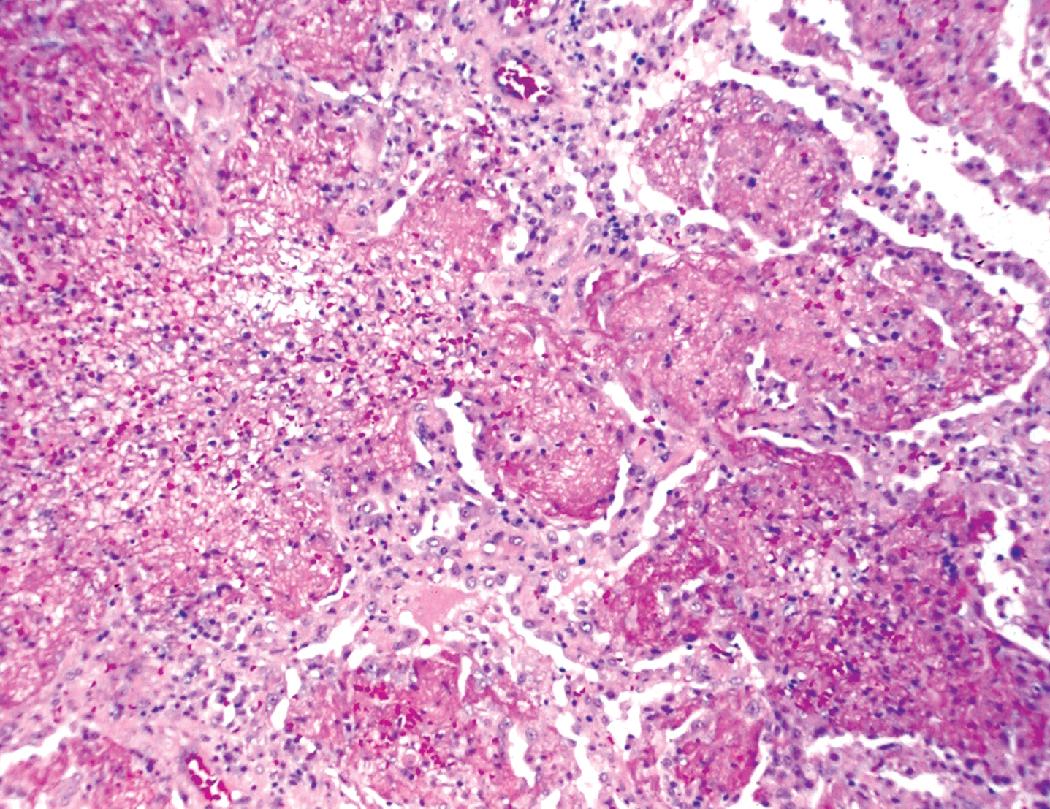
The stereotypic cellular response to pyogenic bacteria is acute inflammation, characterized by variable numbers of neutrophils. Bacteria may be visualized in various stained preparations made from respiratory tract secretions and washings using the Papanicolaou and Diff-Quik methods. The clinical significance of bacteria in such specimens may be limited owing to potential contamination by oral flora and the problem of distinguishing colonization from infection. However, when the upper respiratory tract can be bypassed by means of either transtracheal or transthoracic needle aspiration, the presence of bacteria becomes much more significant, especially when sheets of neutrophils or necroinflammatory debris are present ( Fig. 7.32 A), as would be the case with a typical lobar or lobular consolidation, lung abscess, or other complex pneumonia. , , , In this context, transthoracic needle aspiration can establish the etiologic diagnosis of community-acquired and nosocomial pneumonias in both children and adults when coupled with modern microbiologic methods. , , Proponents consider it an underused technique the potential benefits of which, in experienced hands, outweigh the modest associated risks.
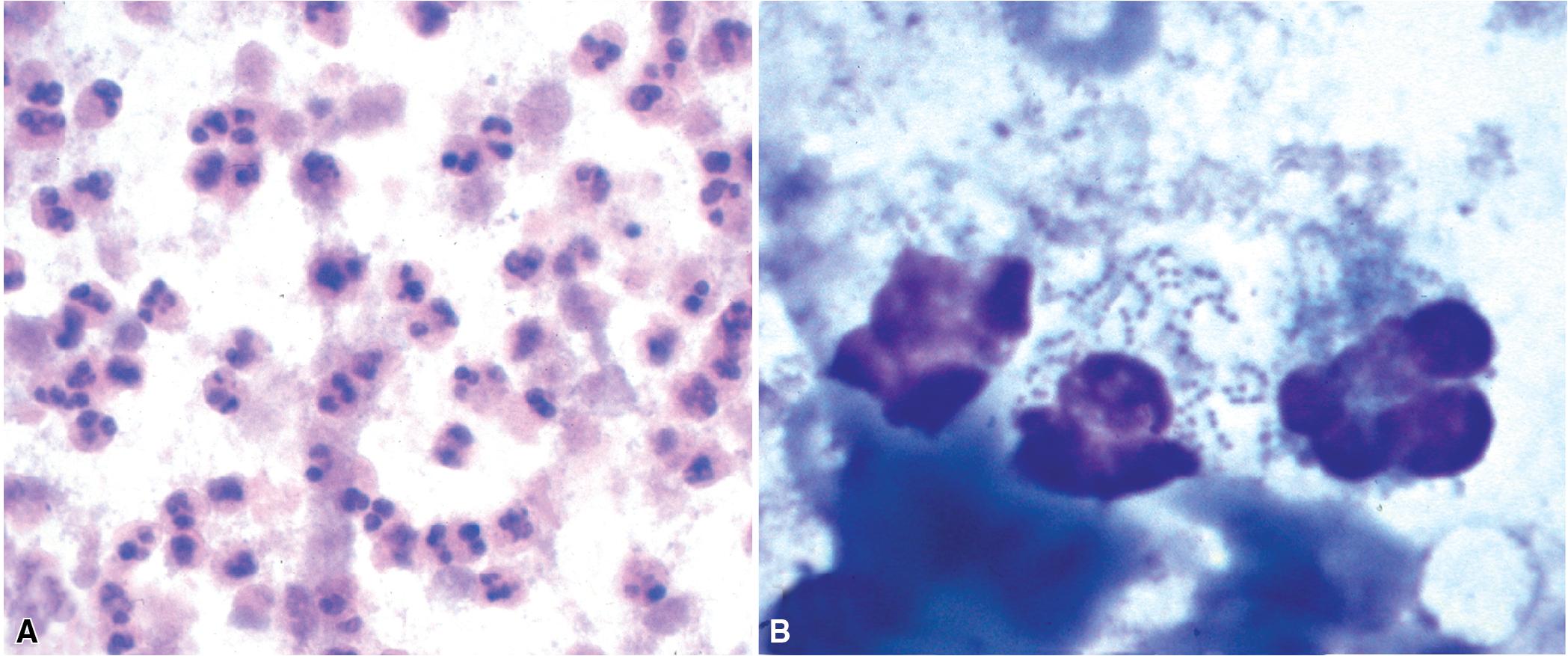
Many types of bacilli and cocci can be seen within and around neutrophils on Diff-Quik–stained smears (see Fig. 7.32 B). A smear can also be prepared for Gram stain and the aspirate needle rinsed in nonbacteriostatic sterile saline or nutrient broths for culture. The size (length and width) and shape of organisms and the Gram reaction allow rough categorization of organisms into groups, such as enteric-type bacilli, pseudomonads, fusiform anaerobic-type bacilli, tiny coccobacillary types suggestive of the Haemophilus–Bacteroides group ( Fig. 7.33 ), or gram-positive cocci. Branching filamentous forms suggest Actinomycetes or Nocardia species ( Fig. 7.34 ), with the latter distinguished by being partially acid-fast. ,
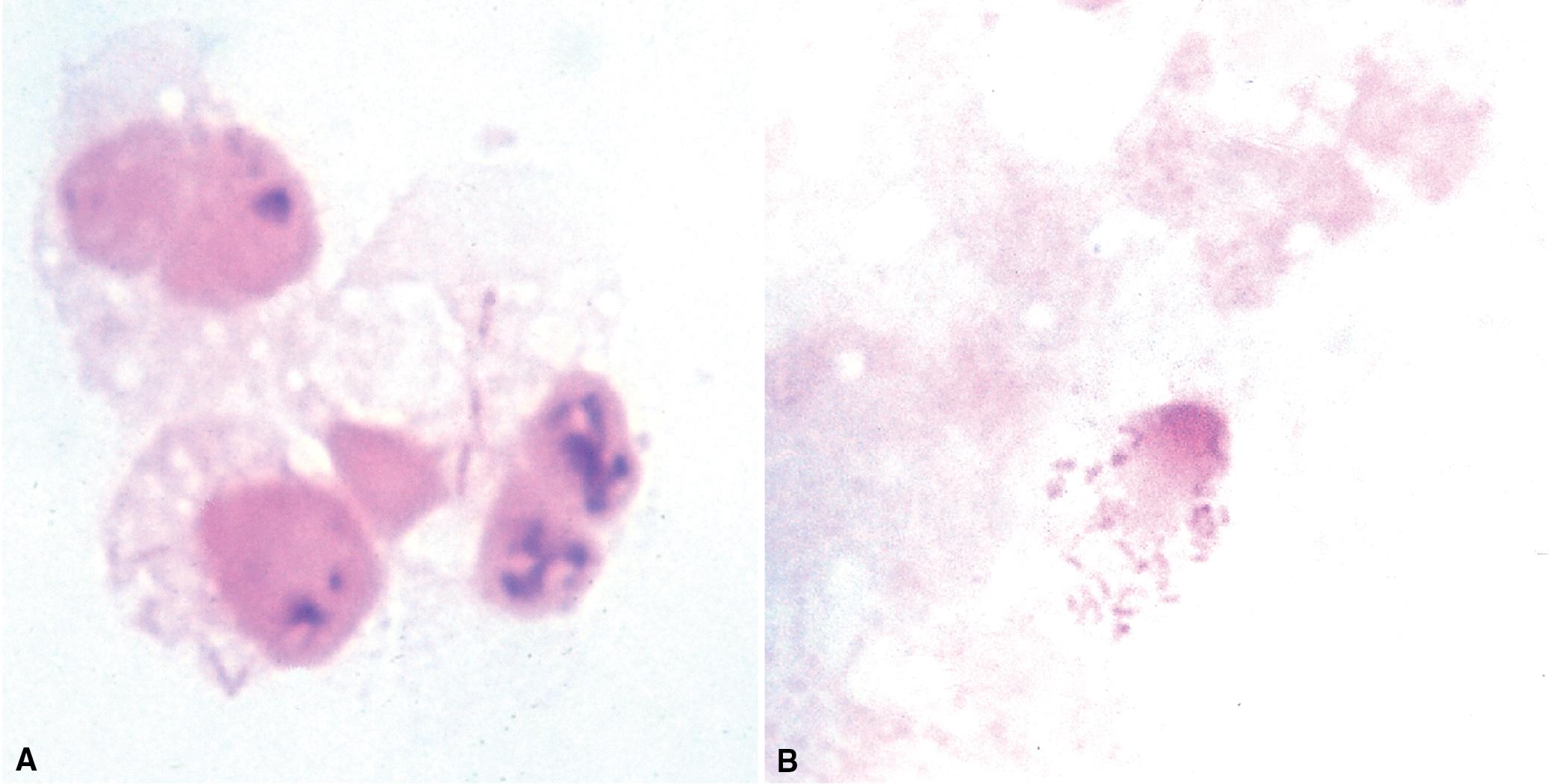
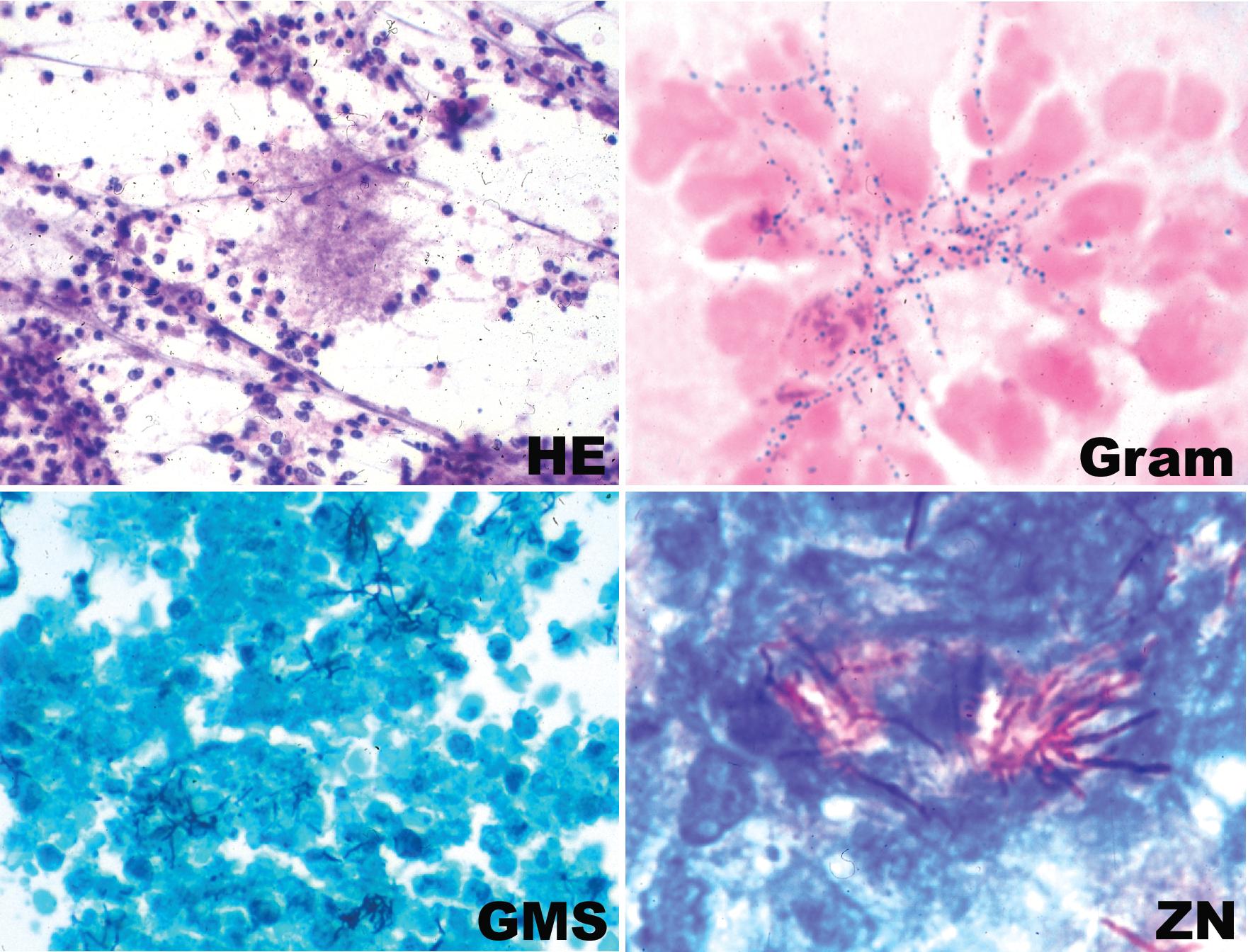
Although most aspirated cavitary lung lesions with the abscess pattern are the result of bacterial infection, considerations in the differential diagnosis include necrotic neoplasm (particularly squamous cell carcinoma), granulomatosis with polyangiitis, and nonbacterial infections associated with suppurative granulomas such as those due to fungi and mycobacteria.
The traditional morphologic and functional approach to microbiologic diagnosis is gradually shifting to molecular methods, and diagnostic arrays of common respiratory pathogens are marketed by several vendors; they are adjusted for laboratory size, for individual random-access testing, or for test batching in larger laboratories.
In those cases where bacteria are visible on H&E-stained sections, the Gram stain can be helpful in confirming a presumptive etiology. For example, pairs and chains of gram-positive cocci in a necro-inflammatory background, suggest a streptococcal pneumonia, whereas numerous slender gram-negative bacilli investing and infiltrating blood vessels are characteristic of Pseudomonas pneumonia ( Fig. 7.35 ). In the case of an abscess, a mixture of gram-positive cocci and gram-negative bacilli in tissue is a useful finding that is helpful in supporting a diagnosis of an anaerobic infection.
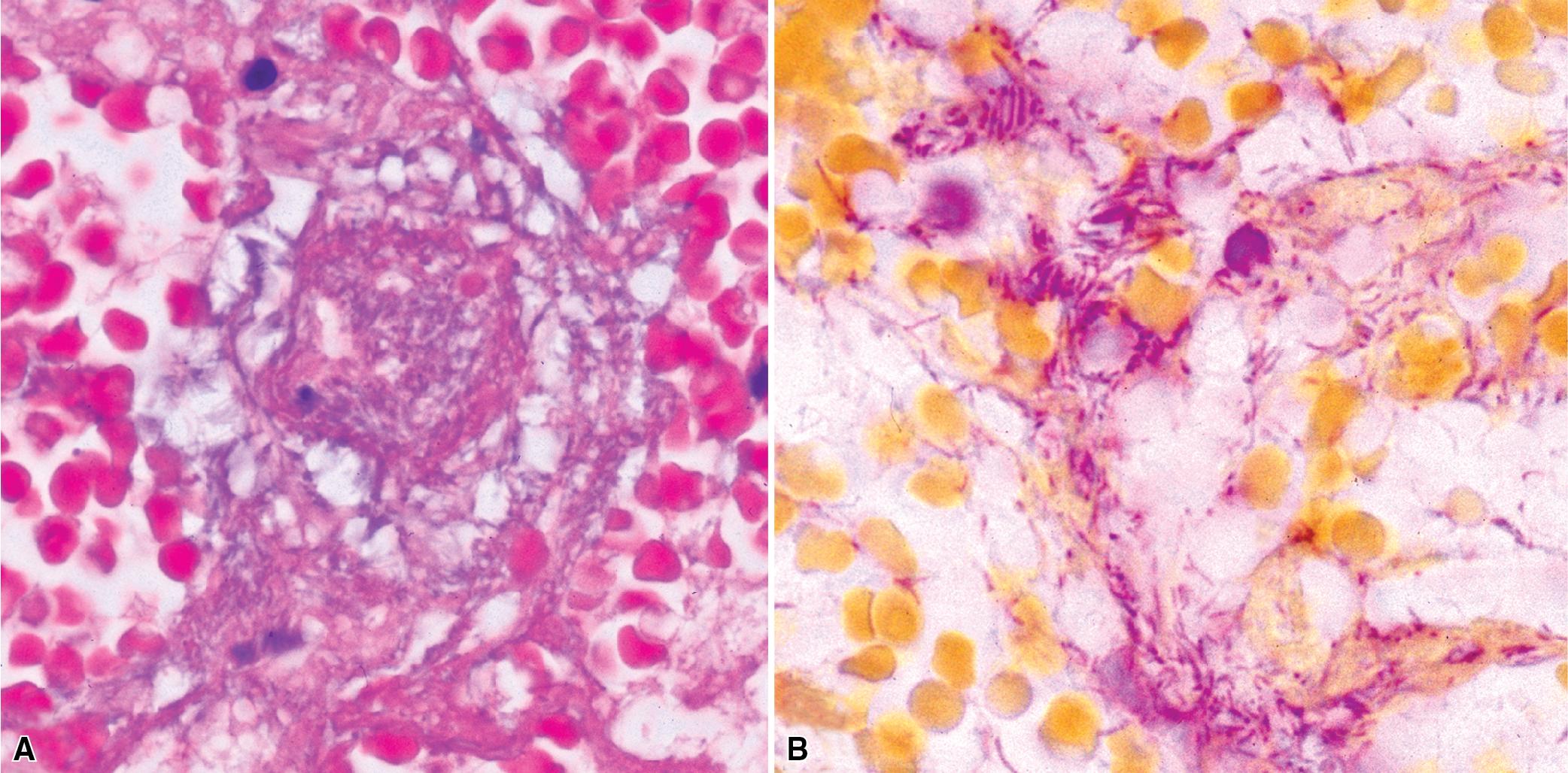
When organisms are sparse, other stains such as Giemsa or silver impregnation may highlight the organisms in the exudates ( Fig. 7.36 ). The Gram stain is also useful for evaluating infections with granules and allows differentiation of the agents of botryomycosis (the gram-positive cocci or gram-negative bacilli) from the filamentous Actinomyces organisms ( Fig. 7.37 ).
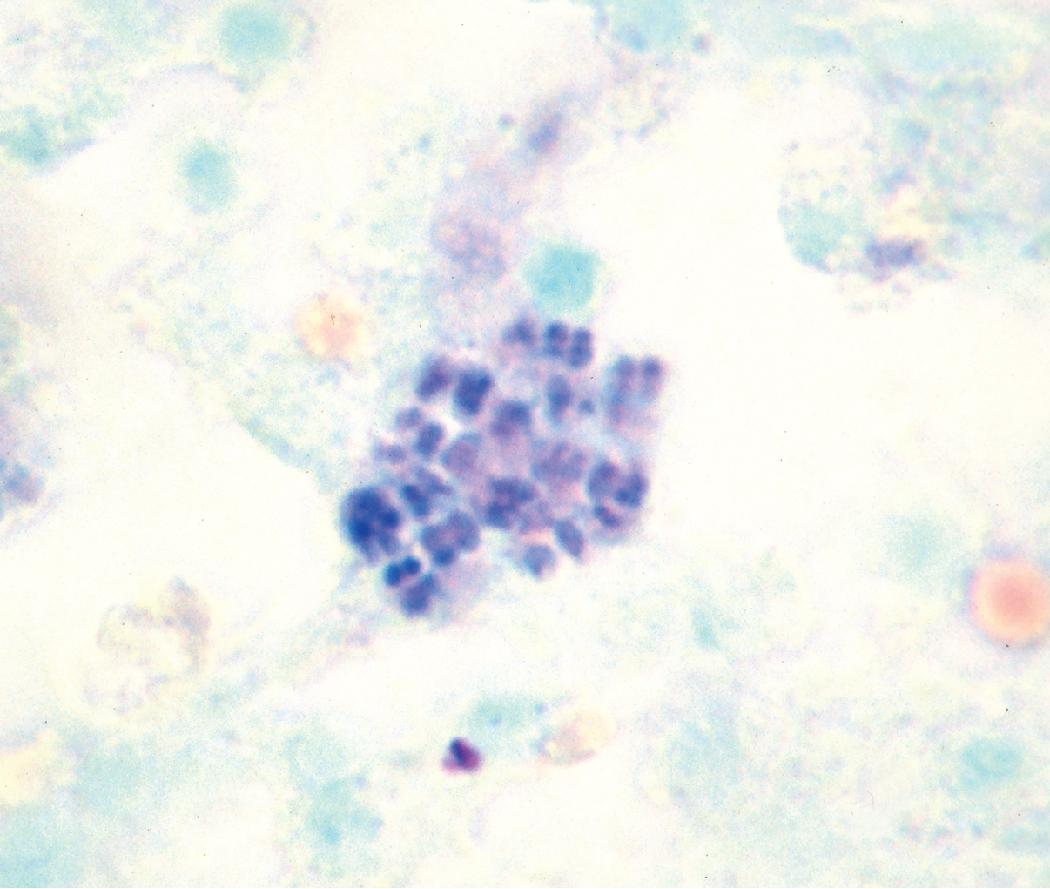
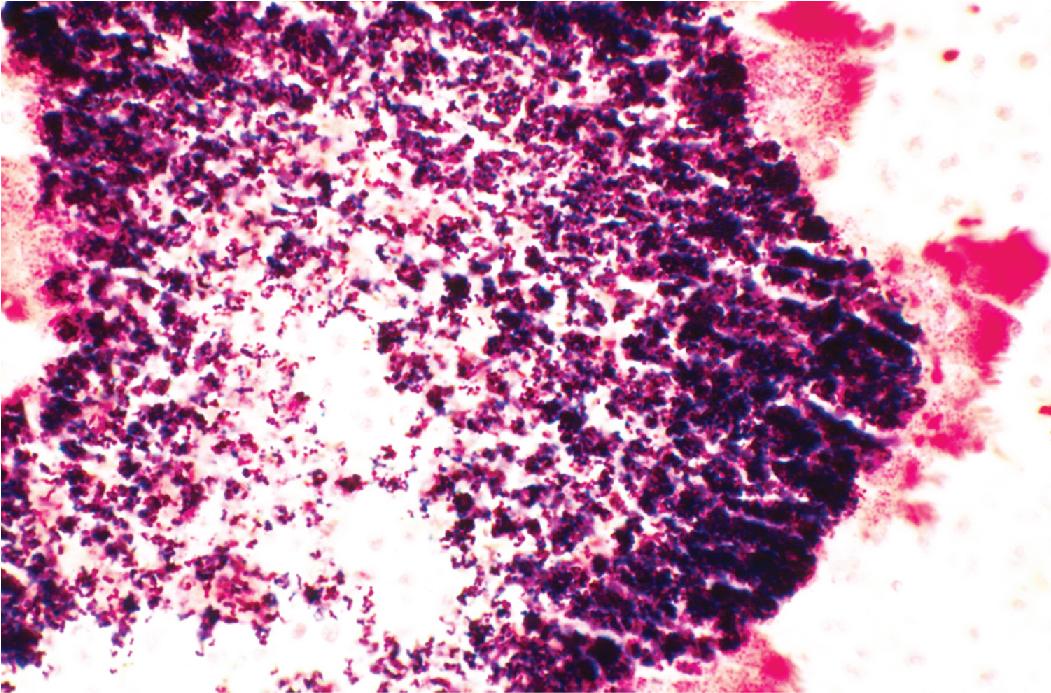
Staining with methenamine silver is the best procedure for detecting Nocardia organisms. The modified Ziehl–Neelsen stain allows for differentiation of Nocardia (positive) from the anaerobic Actinomyces (negative).
Commercially available immunohistochemical reagents exist for relatively few bacterial species. Immunohistochemistry testing for the potential bioterrorist agents discussed in this chapter is available through the CDC in Atlanta, GA. It is expected that commercial reagents will become increasingly available for the common etiologic agents in the near future.
Culture media that will allow recovery of common bacterial species causing pneumonia from various types of respiratory samples (secretions, washings, brushings, aspirates, and tissues) include sheep blood agar, chocolate agar, and McConkey agar. These media also will support growth of B. anthracis and Y. pestis . Buffered charcoal yeast extract (BCYE) agar is the primary medium for Legionella species. Because Legionella organisms survive poorly in respiratory secretions, rapid transport and immediate plating is essential for recovery. BCYE is also a good all-purpose medium for growing other fastidious species, including F. tularensis . However, F. tularensis grows best in cysteine-enriched media.
In general, the laboratory diagnosis of pneumonia caused by most of the atypical agents is difficult because systems are not routinely available or are costly, cumbersome, or unsafe. For the atypical agents ( Mycoplasma , Chlamydia , and Coxiella species), serologic testing has been the method of choice for diagnosis. Classic cold agglutinin and complement fixation tests for these agents have largely been replaced by enzyme immunoassay and micro- immunofluorescence testing. , , Serologic methods are also useful for the diagnosis of tularemia because of the difficulty in culturing the fastidious bacterium.
Legionella pneumonia is a common form of severe pneumonia that is not readily diagnosed for a number of reasons, including the organism’s fastidiousness. In the microbiology laboratory, the direct fluorescent antibody test and culture on buffered BCYE agar have been the mainstays of diagnosis. Culture is considered the diagnostic gold standard but is only 60% sensitive. Serologic testing is available for most of the Legionella pneumophila serotypes, which account for 90% of the pneumonia cases; however, the need to collect paired sera weeks apart limits its usefulness in the acutely ill patient. Antigen detection in urine has become commercially available for both L. pneumophila and S. pneumoniae ; because the need to collect acute and convalescent sera is obviated, it has become a frequently used diagnostic test. , Its advantage lies in its potential to effect early treatment decisions through rapid diagnosis. Its disadvantage lies in the fact that it identifies only patients infected with L. pneumophila serogroup 1 (LP1), the most prevalent species and serotype, but none of the non-LP1 serotypes or cases due to other Legionella species.
The use of molecular diagnostic tools (in situ hybridization and nucleic acid amplification by PCR or other methods) to detect these agents has been reported. , , PCR nested assays are replacing more and more of the above classical methods with sensitive, specific, and rapid diagnostic technique. Multiplex assay, to detect multiple agents in a single reaction, would seem to be an ideal pursuit for the laboratory diagnosis of the most common community-acquired pneumonias, including those due to the atypical pneumonia agents. , More recently, MALDI-TOF mass spectrometry-based methods have emerged as a high-throughput technique for rapid, sensitive, and highly specific identification of bacteria and other organisms, revolutionizing the clinical microbiology field and rapidly replacing many conventional assays in larger clinical laboratories.
The presence of purulent exudates or significant numbers of neutrophils in biopsy or cytologic samples should always trigger a search for bacterial infection. Because lung biopsies are usually performed late in the clinical course after procedures have been performed and bacterial infections have been excluded and/or treated with antibiotics, neutrophilic exudates may not signify bacterial infection unless accompanied by necrosis, as in an abscess. Instead, consideration should be given to one of several noninfectious acute inflammatory diseases, with an immunologic basis, that can mimic bacterial infection. Some of these include granulomatosis with polyangiitis, anti-GBM disease, systemic lupus erythematosus, and microscopic polyangiitis, all conditions that can produce acute inflammation predominantly involving alveolar septal blood vessels (“capillaritis”). On occasion, capillaritis can result in airspace accumulation of neutrophils, further raising concern for bronchopneumonia. Centrally necrotic or cavitary neoplasms of various types may mimic abscesses grossly and microscopically, and exceptionally well-differentiated adenocarcinomas containing glands filled with detritus may mimic inflammatory and bacterial diseases. Suppurative granulomas can have a bacterial, mycobacterial, or fungal etiology. Even the miliary necro-inflammatory lesion typical of bacterial infection can be produced by viruses, some fungi, and even protozoa (e.g., Toxoplasma gondii ). Aspiration, common in hospitalized patients, may manifest with an acute bronchopneumonia/bronchiolitis type of pattern, and it should also be in the differential diagnosis as a contributing or etiologic factor when considering most pneumonias; microscopic identification of foreign material is a definitive diagnostic clue, frequently gained only from histopathologic examination.
Tuberculosis is but one of several different types of lung infection that can manifest clinically as community-acquired pneumonia, resulting in delay until an invasive procedure such as transbronchial biopsy, transthoracic needle biopsy, or surgical lung biopsy is performed, often as a “last resort” effort. , In recent years, delays in the diagnosis of mycobacterial infection have markedly decreased, thanks in part to recommendations from the CDC for improving laboratory turnaround time and to the response of the diagnostics industry with better methods and technology. Because direct acid-fast smears of respiratory specimens yield negative findings in at least half of the cases, and because many mycobacterial species are fastidious and slow-growing, the biopsy results may be the first suggestion of a mycobacterial infection. The biopsy findings can also define the organism’s relationship to a histopathologic lesion and host response—important information in evaluating the significance of a culture result. Although an isolate of Mycobacterium tuberculosis is always taken seriously, obtaining a single isolate of a nontuberculous mycobacterium from the respiratory tract does not necessarily implicate the organism as the cause of disease.
The mycobacterial species can be divided into two clinically relevant groups: M. tuberculosis complex (MTC) and the nontuberculous mycobacteria (NTM). MTC includes the subspecies M. tuberculosis , Mycobacterium bovis , Mycobacterium africanum , and Mycobacterium microti . The last three species produce tuberculosis in some areas of the world, but in the United States the prevalence of such disease is very low.
M. tuberculosis is the most virulent mycobacterial species and an unequivocal pathogen that is responsible for significant morbidity and mortality worldwide. This organism is the etiologic agent of tuberculosis in its various forms, which are listed in Box 7.2 .
Gram stain (bacteria)
Brown and Brenn
Brown and Hopps
Silver stains (bacteria and fungi)
Warthin-Starry
Steiner
Dieterle
Fungal stains
Grocott methenamine silver (GMS)
Periodic acid–Schiff reagent (PAS)
Mycobacterial stains
Ziehl–Neelsen (heat)
Kinyon (cold)
Auramine O (fluorochrome)
Fite-Faraco (peanut or mineral oil)
Other tissue stains
Giemsa; Diff-Quik
Mucicarmine
Modified trichrome (Weber)
Fontana–Masson
Chemofluorescent (optical brighteners)
Immunofluorescent antibodies
Immunohistochemical
Primary tuberculosis occurs in patients without previous exposure or with the loss of acquired immunity. Progressive primary tuberculosis occurs in patients with inadequate acquired immunity—that is, impaired cellular immunity. Postprimary tuberculosis, also referred to as secondary or reinfection-reactivation tuberculosis , occurs in patients with previous immunity to the organism and accounts for most clinical cases of tuberculosis. , Many clinical experts consider that most cases of active tuberculosis in adults with normal immunity arise from reactivation of latent infection (postprimary tuberculosis), whereas reinfection with a new strain derived from the environment (primary or postprimary tuberculosis) can occur in the immunocompromised patient. More recently, DNA fingerprinting methods (genotyping) have challenged this dogma by showing that exogenous reinfection accounts for a significant percentage of cases in some areas of the world. Miliary tuberculosis and extrapulmonary disease can occur with any of these forms. ,
Primary tuberculosis is usually a mild illness that is often not recognized. The bacillemia that occurs during its development can seed extrapulmonary organs and set the stage for subsequent reactivation. Approximately 5% of patients pass through latency to postprimary disease within 2 years of primary infection, and another 5% do so later in their lives.
Recognized NTM species, many of which were identified during the past decade, number more than 125. , However, relatively few cause pulmonary disease. , These organisms are acquired from the environment, where they are ubiquitous. In contrast with M. tuberculosis , the NTM are not spread from person to person. In most instances, patients in whom NTM infection develops have chronic lung disease and other risk factors, such as AIDS, alcoholism, or diabetes. Reports of NTM infections in nonimmunocompromised patients are increasing. , MAC and then Mycobacterium kansasii are the most frequent isolates in all settings. Among a growing number of species causing lung disease are Mycobacterium abscessus , Mycobacterium fortuitum , Mycobacterium szulgai , Mycobacterium simiae , Mycobacterium xenopi , Mycobacterium malmoense , Mycobacterium celatum , Mycobacterium asiaticum , and Mycobacterium shimodii . These species manifest marked geographic variability with respect to prevalence and severity. Of note, however, since 1985, more MAC isolates than M. tuberculosis have been reported in the United States.
The histopathologic patterns produced by mycobacteria are listed in Box 7.3 . The radiologic, gross, and microscopic patterns of mycobacterial disease reflect the virulence of the various mycobacterial species as well as the patient’s prior exposure and immune status.
Large nodules with or without cavities
Well-formed granuloma
Poorly formed granuloma
Suppurative granuloma
Histiocytic aggregates
Miliary nodules
Calcified nodules
Granulomatous interstitial pneumonitis
Bronchitis/bronchiectasis
Spindle cell pseudotumors
M. tuberculosis occurs typically in the best-aerated lung regions (anterior segments of the upper lobes, lingua and middle lobe, or basal segments of the lower lobes). The disease passes through progressive phases of exudation, recruitment of macrophages and T lymphocytes, and granuloma formation followed by repair with granulation tissue, fibrosis, and mineralization. , Macrophage-laden bacilli also travel to the hilar lymph nodes, where the phases are repeated. This combination of events produces the classic Ghon complex, consisting of a peripheral 1- to 2-cm lung nodule ( Fig. 7.38 ) and an enlarged, sometimes calcified hilar lymph node. In both locations, the histopathologic hallmark is a necrotizing granuloma ( Fig. 7.39 ) composed of epithelioid cells with variable numbers of Langhans giant cells, a peripheral investment of lymphocytes, and a central zone of caseation necrosis, a form of necrosis attributed to apoptosis. , A spectrum of lesions may be seen, from the tuberculoid “hard” granuloma without necrosis and rare organisms to the multibacillary necrotic lesion with scant epithelioid cells. In a minority of patients the lesions enlarge and progress as a result of increased necrosis or liquefaction.
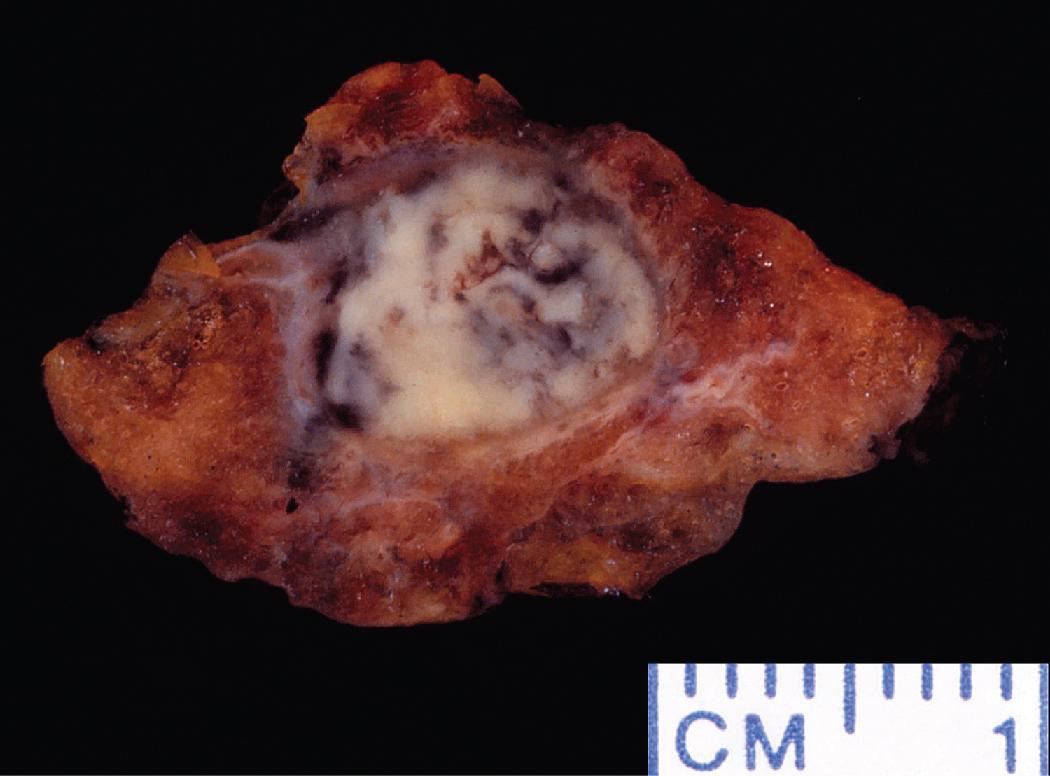
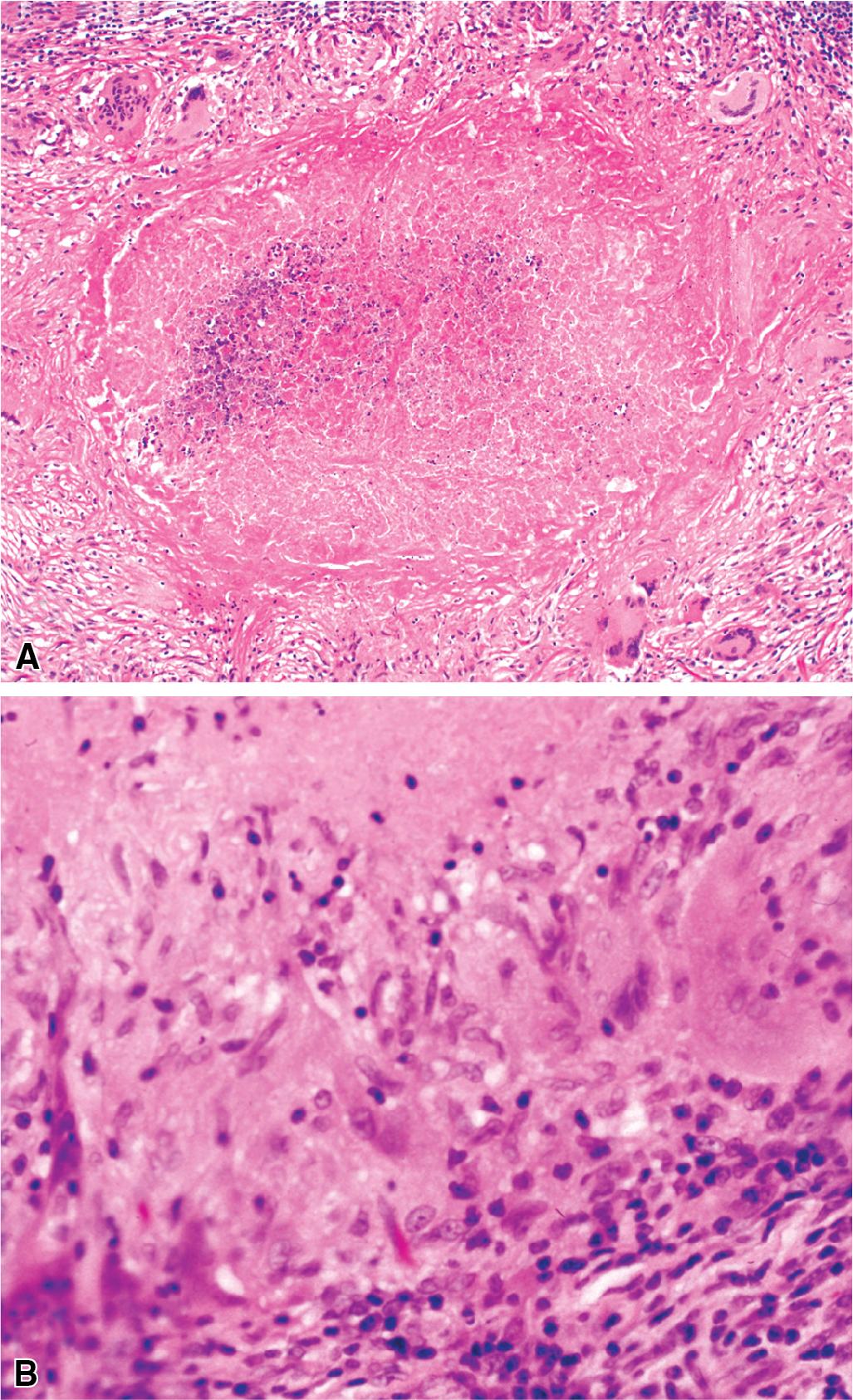
The complications of tuberculosis are illustrated in Fig. 7.40 . Other complications may include extension into blood vessels with miliary ( Fig. 7.41 ) or systemic dissemination, lymphatic drainage into the pleura with granulomatous pleuritis and effusions, involvement of bronchi by bronchocentric granulomatous lesions ( Fig. 7.42 ), or tuberculous bronchopneumonia. Granulomas may also encroach upon blood vessels, mimicking a “granulomatous” vasculitis. The hemophagocytic syndrome, which has been implicated in a variety of bacterial, viral, and parasitic infections, has also been associated with tuberculosis.
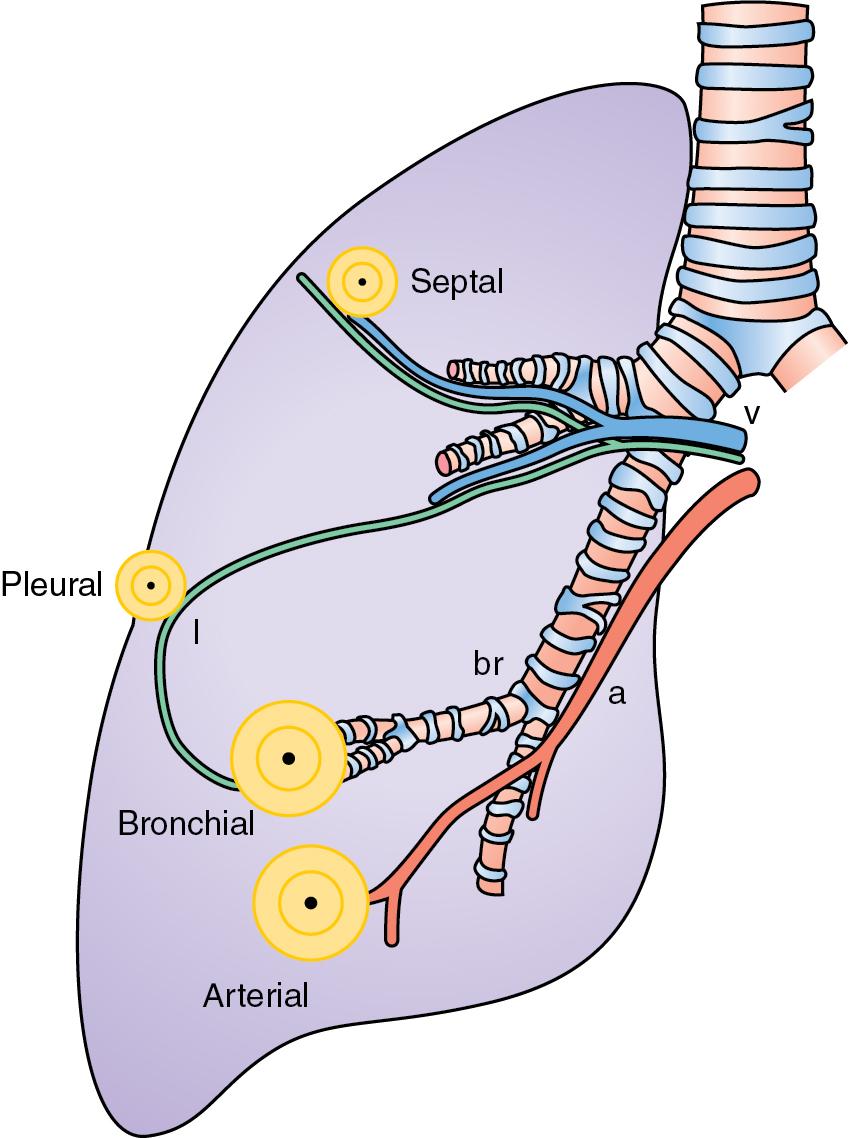
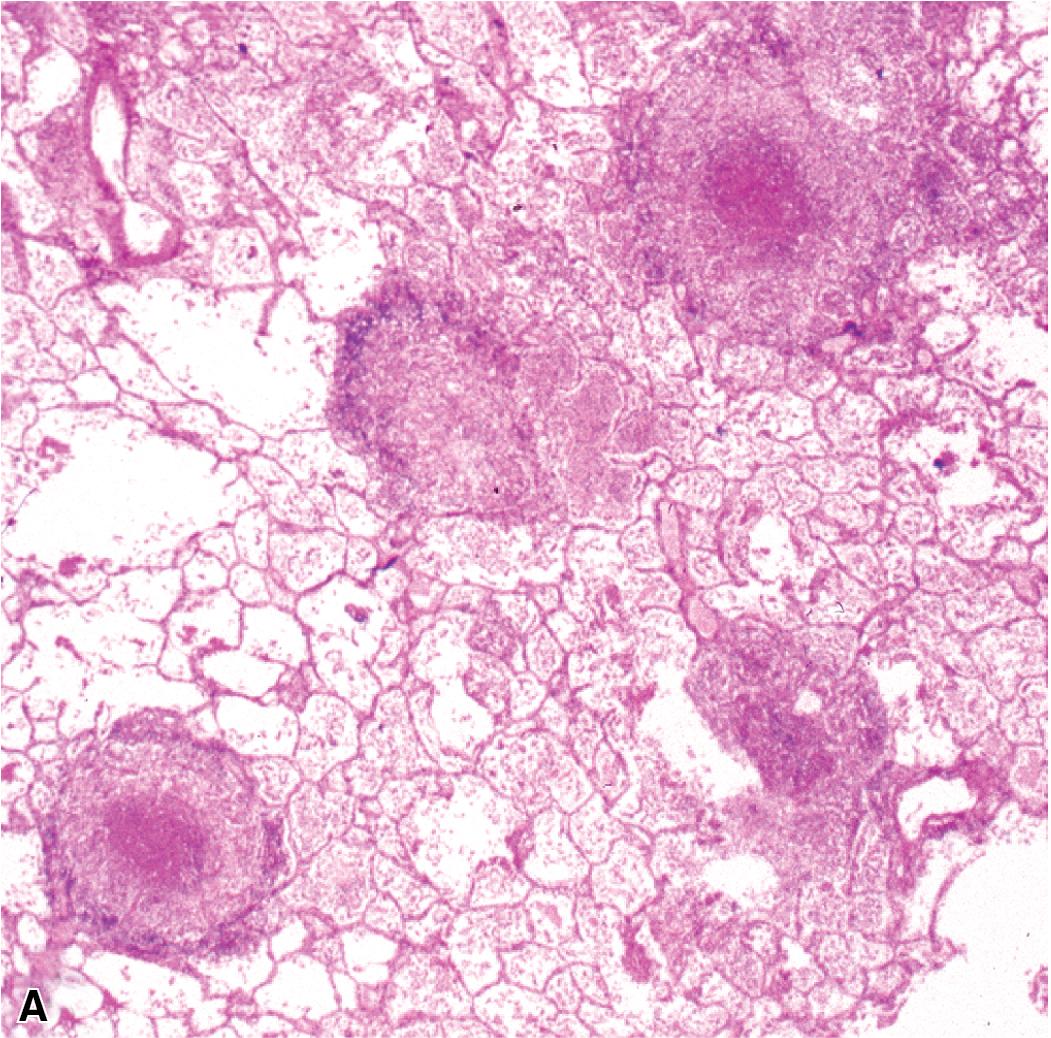
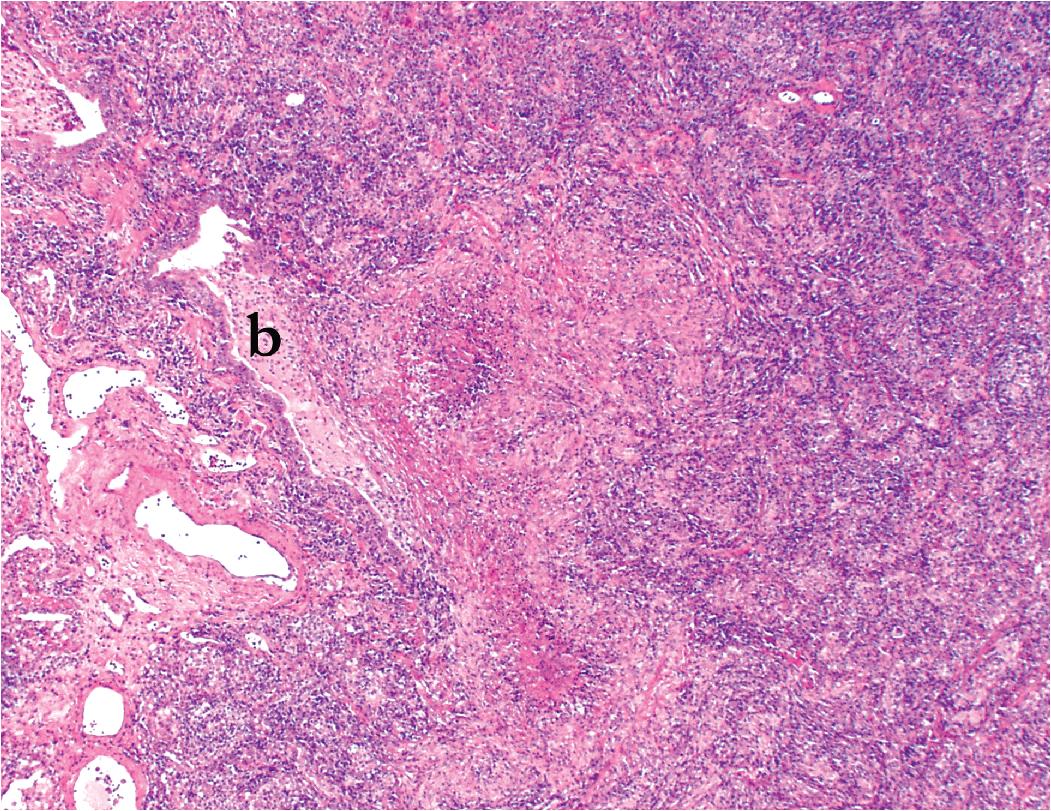
Postprimary tuberculosis, the most common form in adults, typically involves the apices of the upper lobes, producing granulomatous lesions with greater caseation, often with cavities and variable degrees of fibrosis and retraction of the parenchyma. , Fibrosis and bronchiectasis occur with the healing of cavities and is the major cause of pulmonary disability in this disease. Recent studies have proposed that postprimary disease begins as a form of lipoid pneumonia, with bacilli-laden foamy alveolar macrophages and bronchiolar obstruction progressing to caseating cavitary disease and microvascular occlusion due to delayed-type hypersensitivity. Extension to other lobes or hilar/mediastinal lymph nodes and miliary spread through the lungs and to extrapulmonary sites can occur. Other presentation patterns include acute and organizing diffuse alveolar damage with advanced or miliary disease, acute tuberculous bronchopneumonia, and the solitary pulmonary nodule (tuberculoma). A proximal endobronchial form may mimic a neoplasm, noteworthy for its necrosis and large numbers of bacilli. Because characteristic granulomatous morphology may not be visible around the necrotic material, stains for mycobacteria should be considered for all necrotic endobronchial samples.
Tuberculosis is a rare cause of chronic pleural effusion. Pleural biopsy may be included when clinical suspicion for tuberculosis is high, both to improve recovery of the organisms and to visualize granulomas. The presence of pleural caseating granulomas can be considered nearly diagnostic of tuberculous pleural effusion and a powerful indication for treatment ; lack of true caseation in the granulomas expands the differential diagnosis to include sarcoid, fungal infection, and rheumatoid disease.
Become a Clinical Tree membership for Full access and enjoy Unlimited articles
If you are a member. Log in here